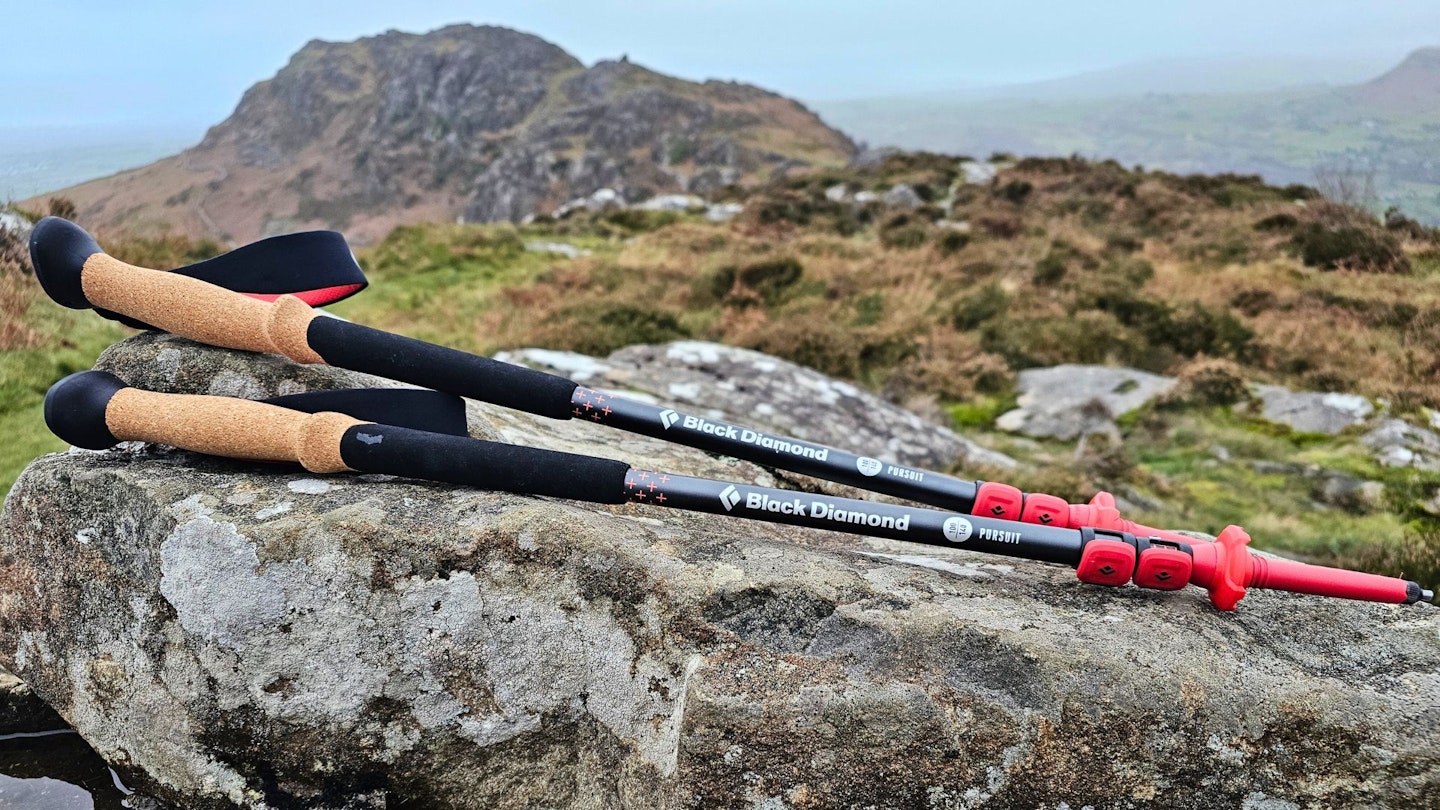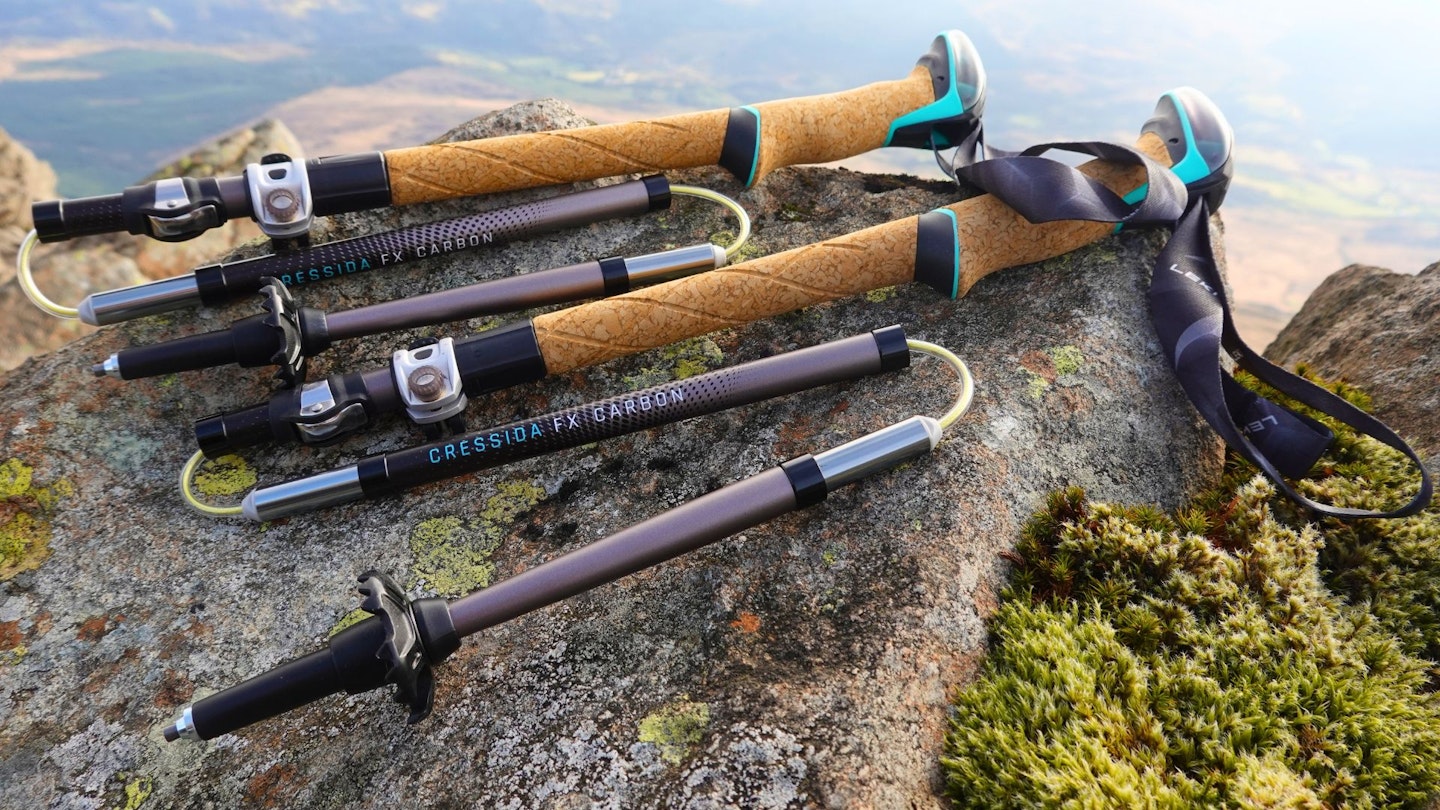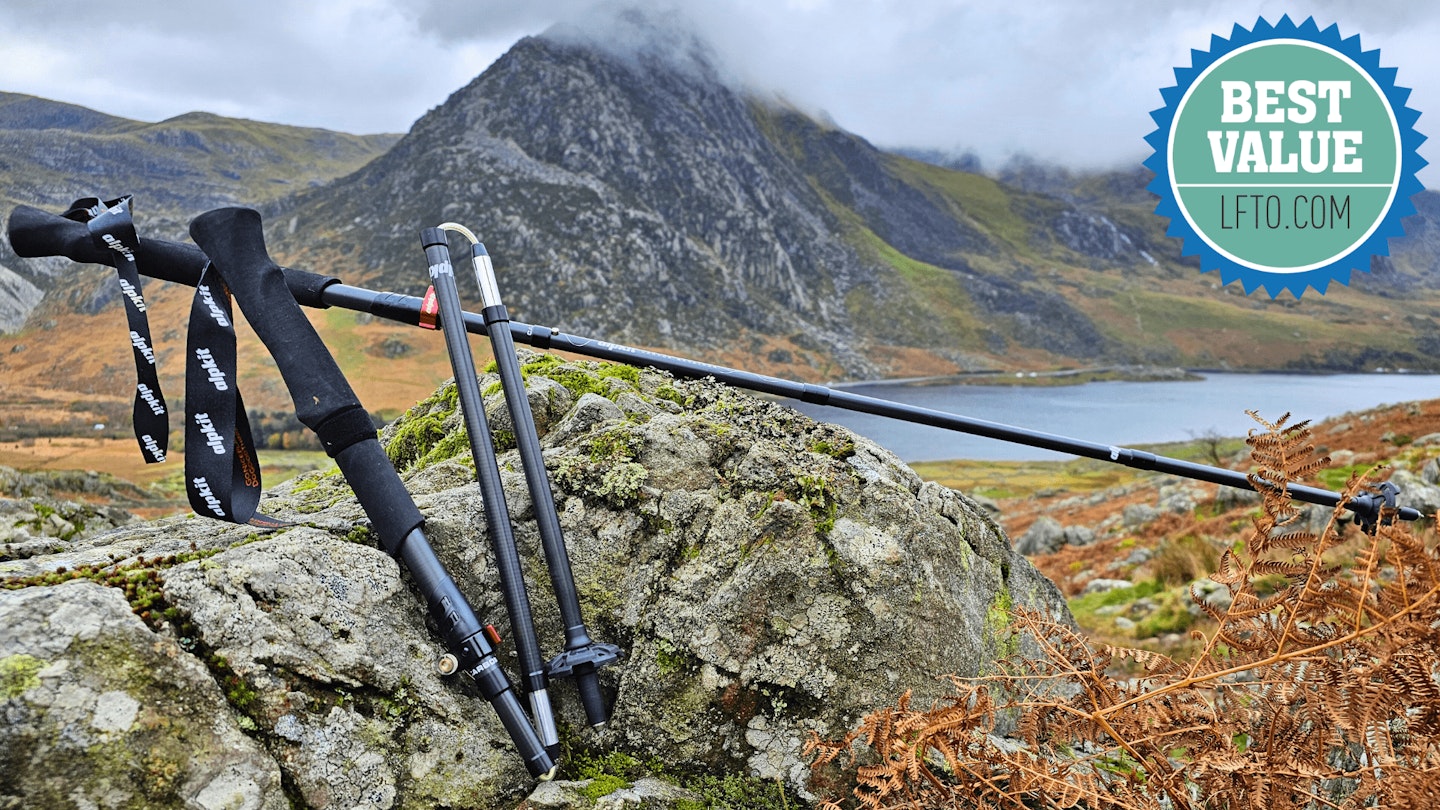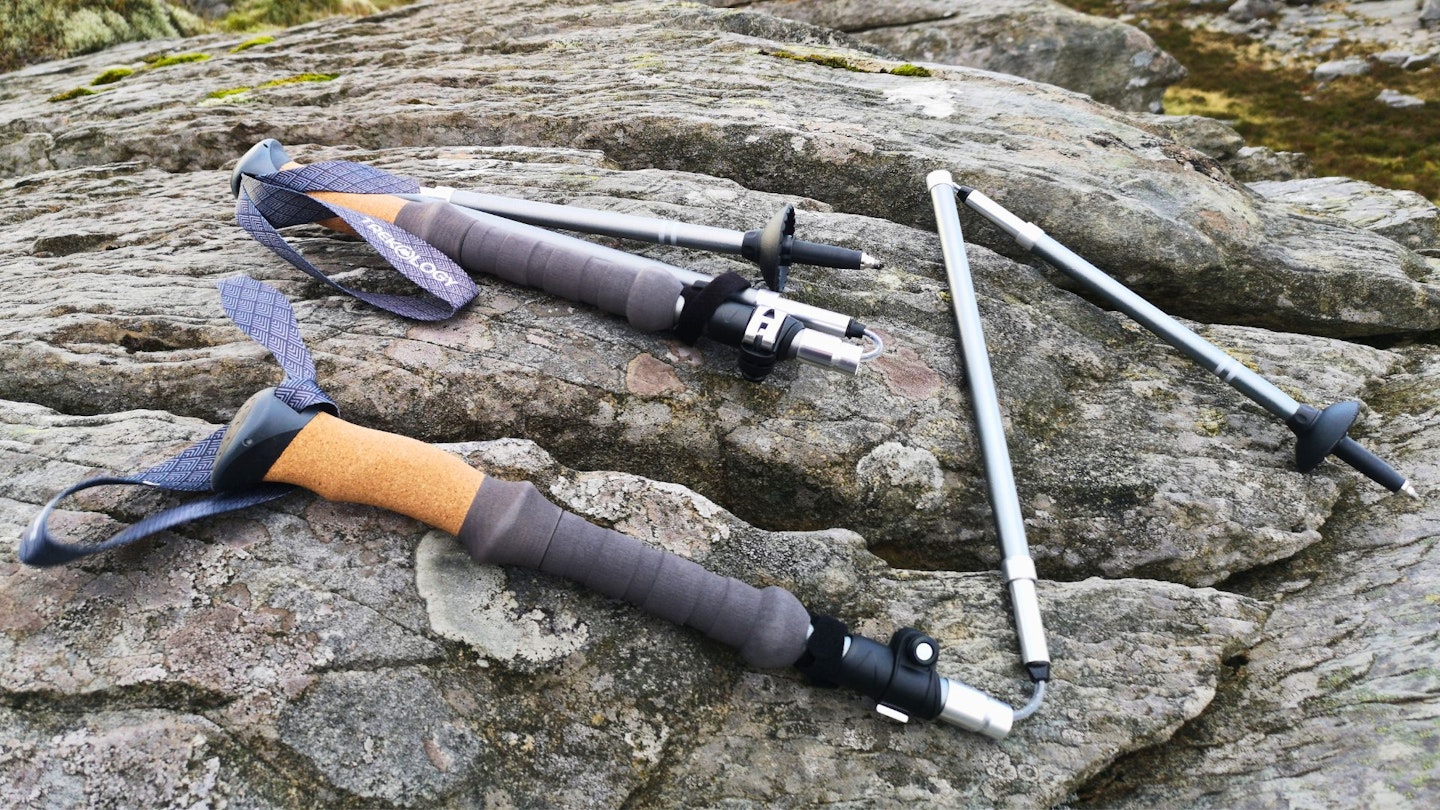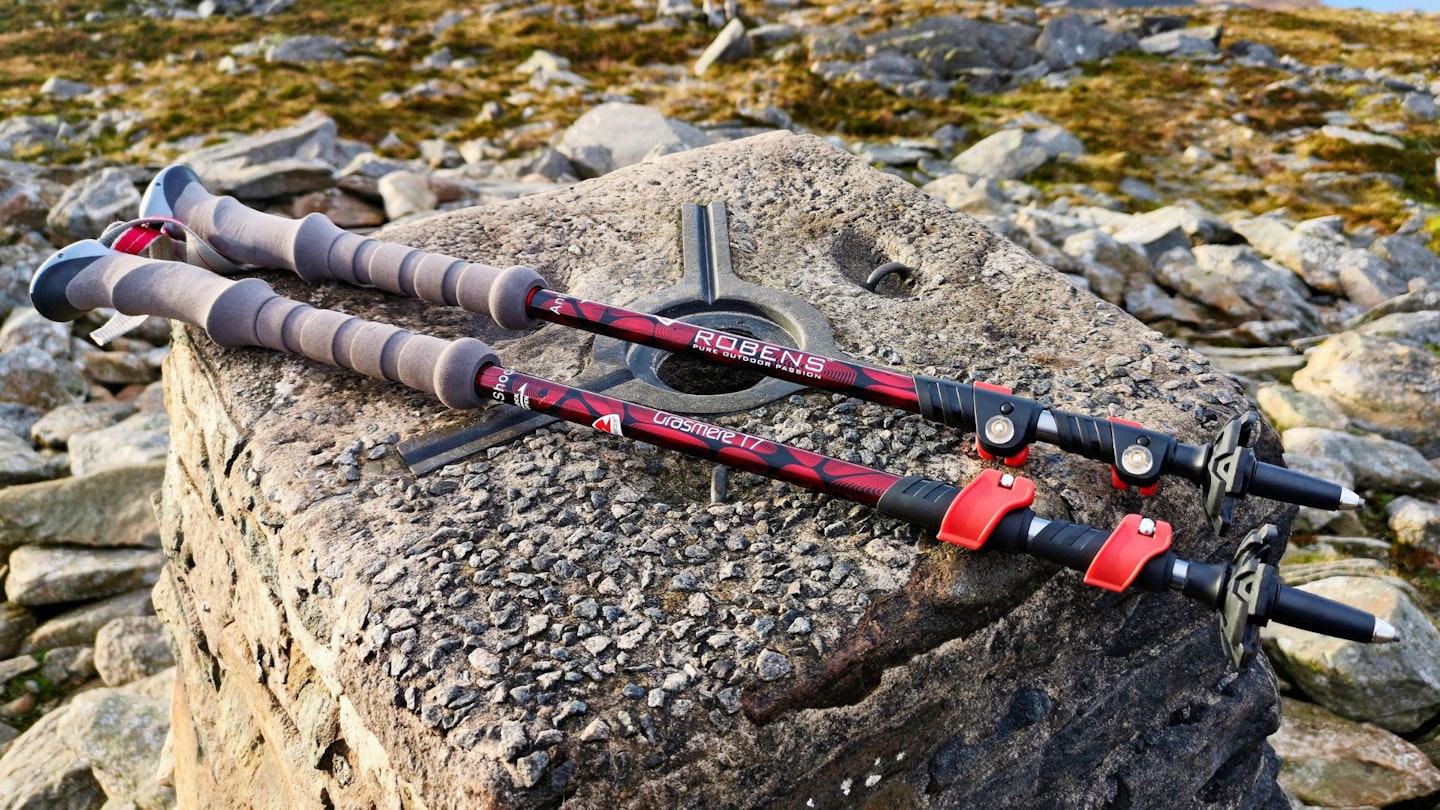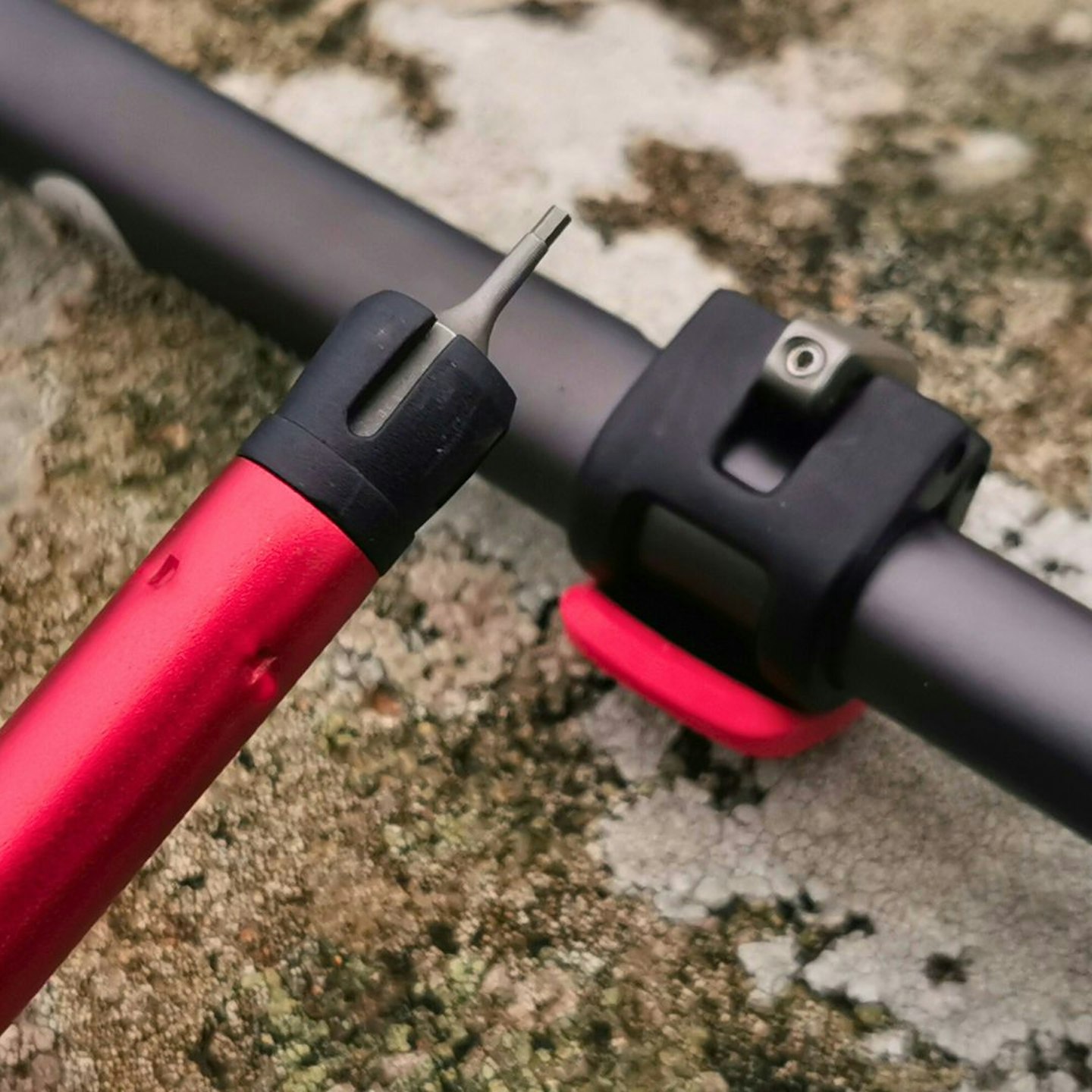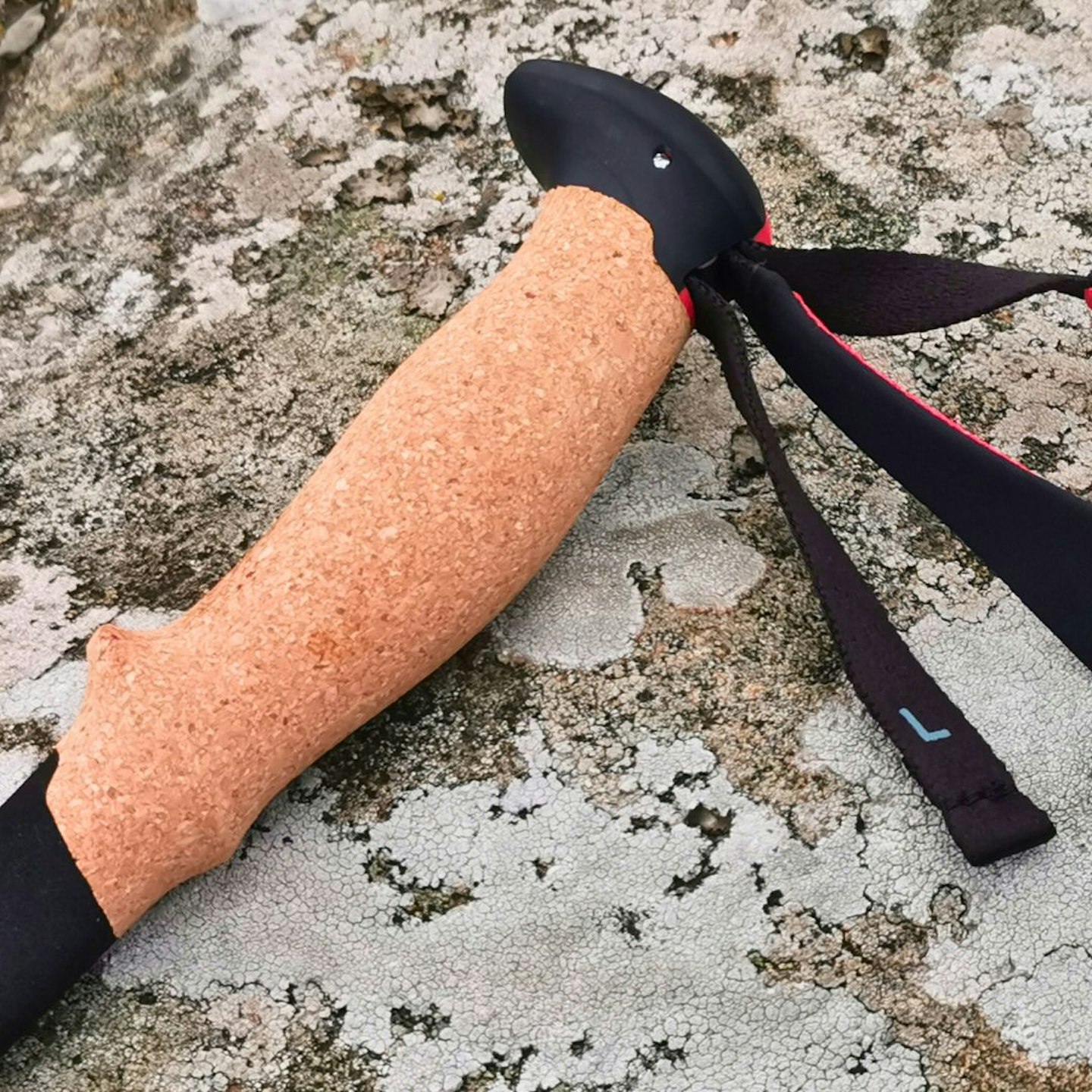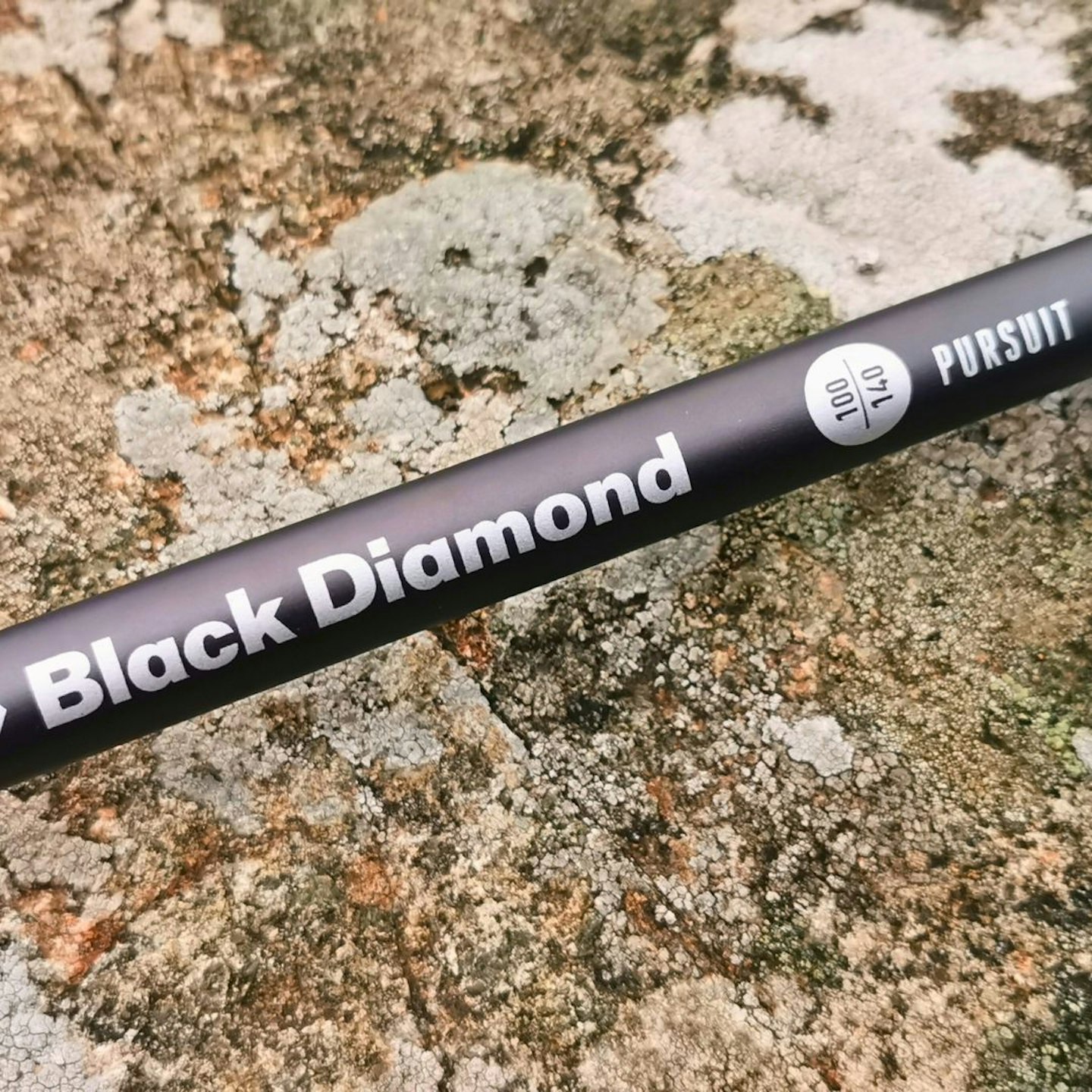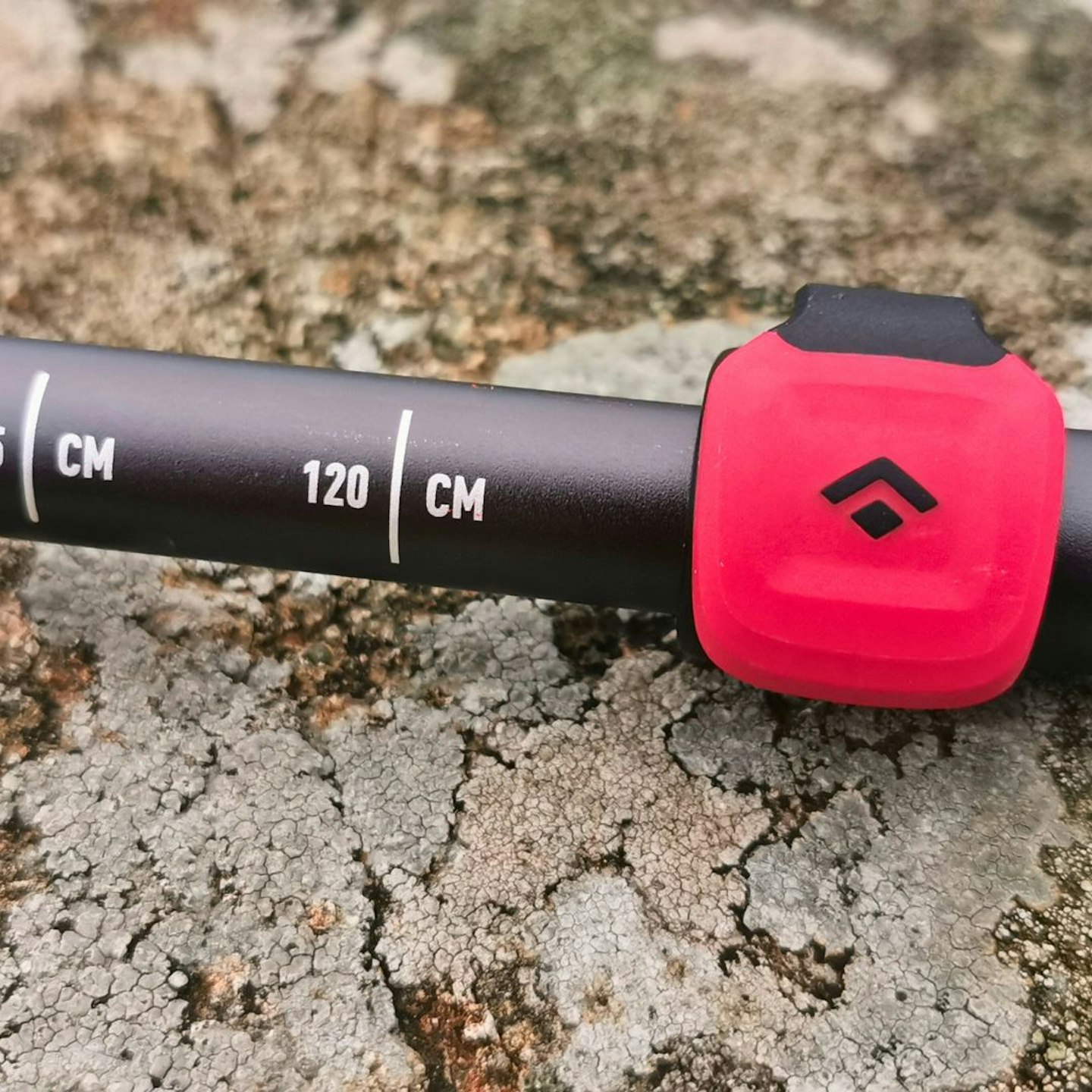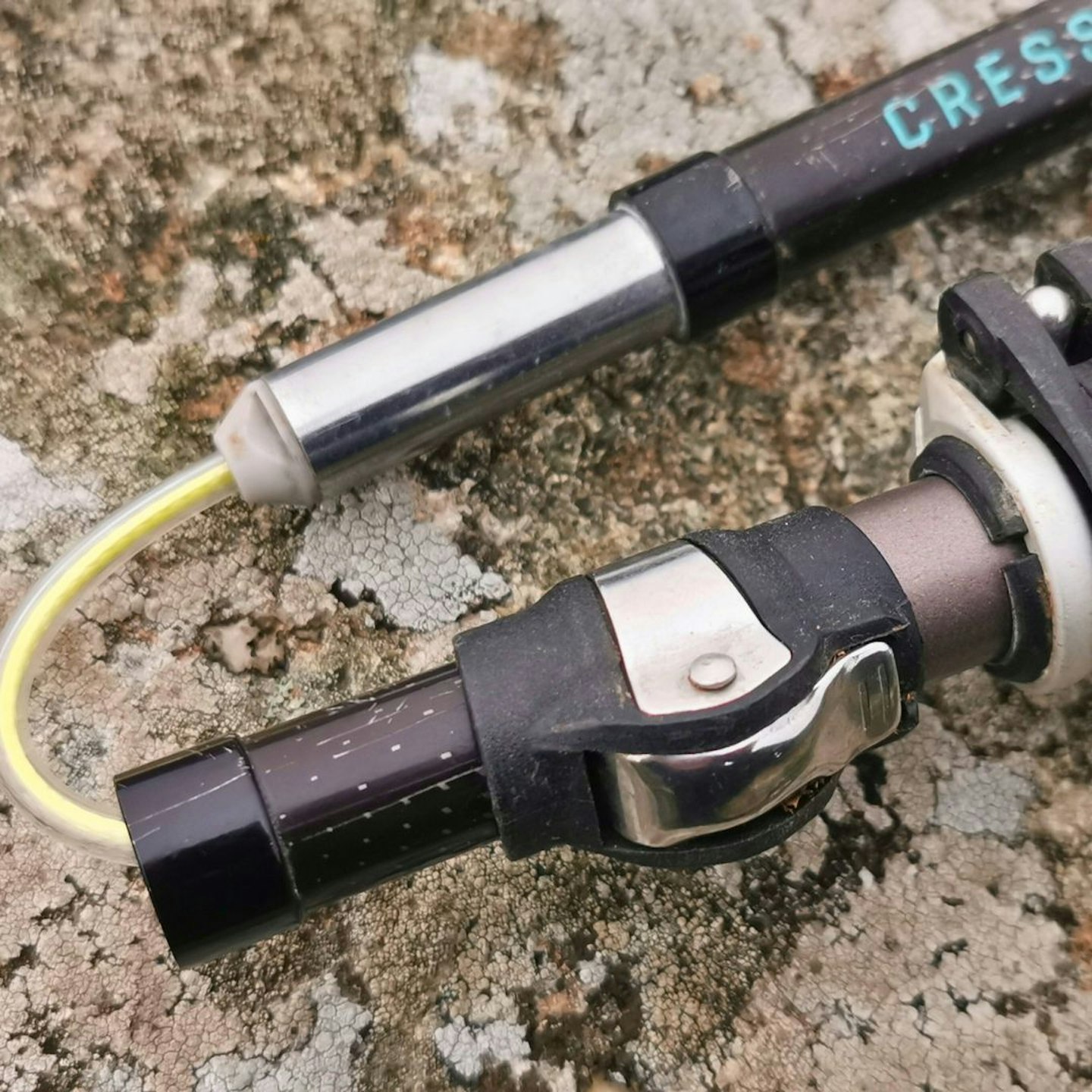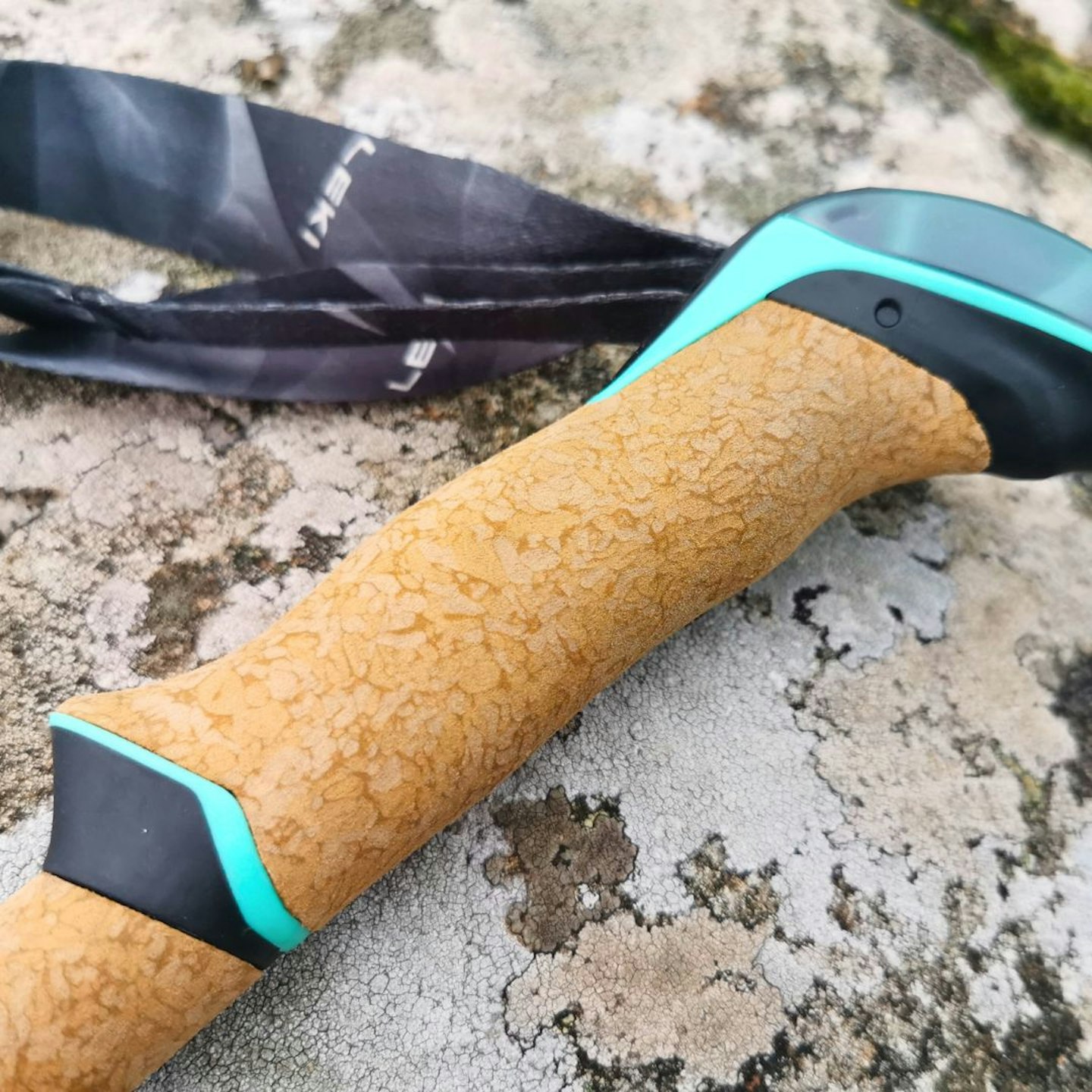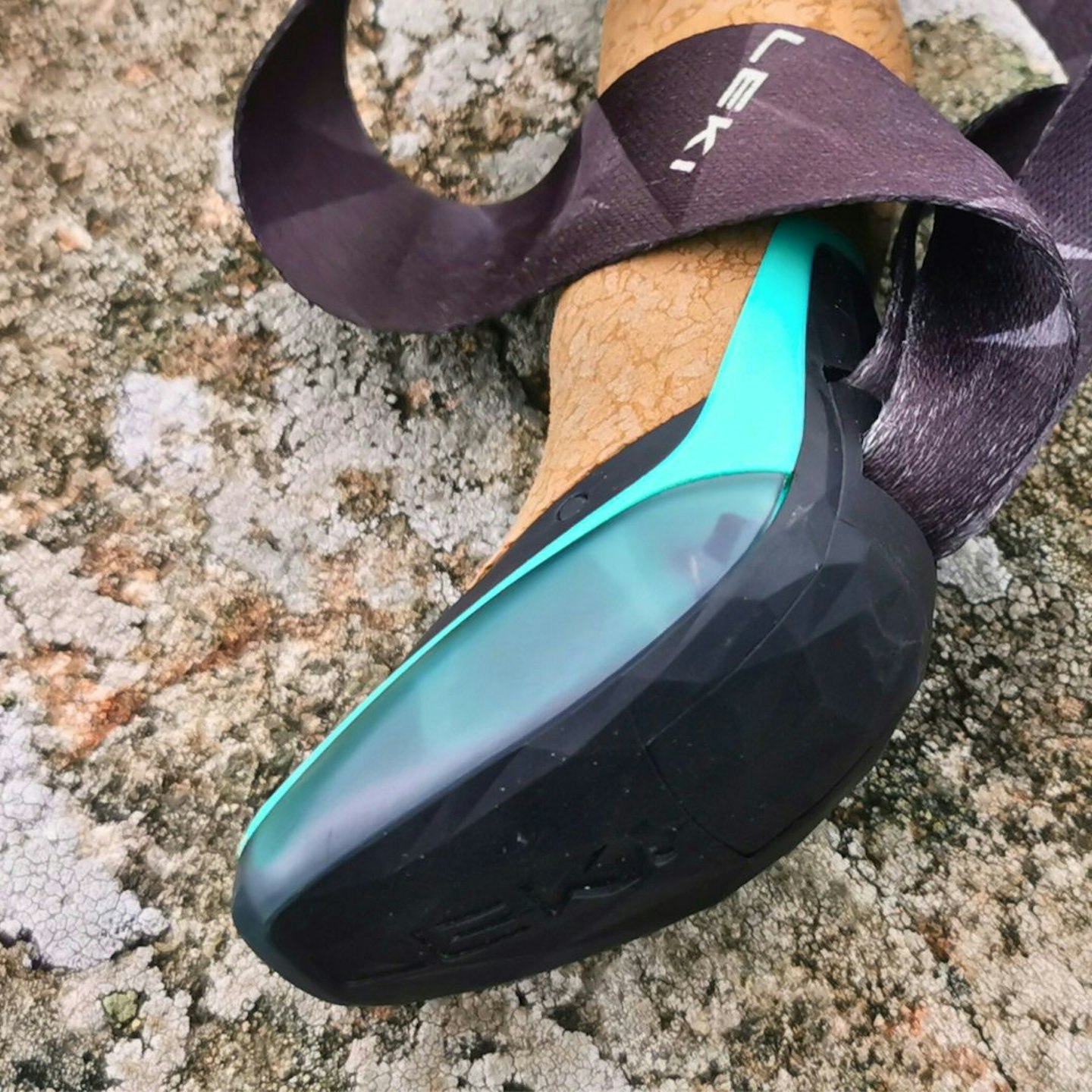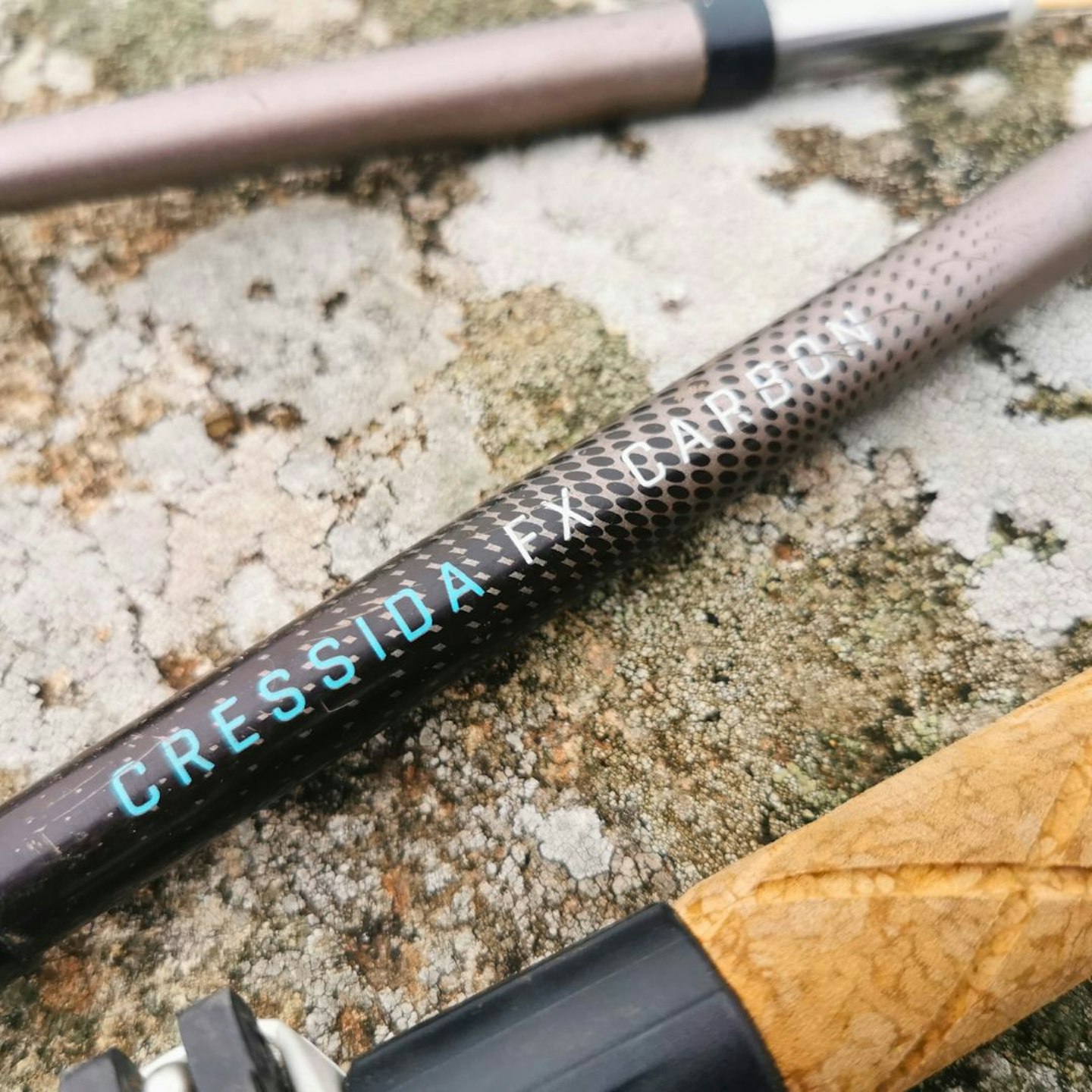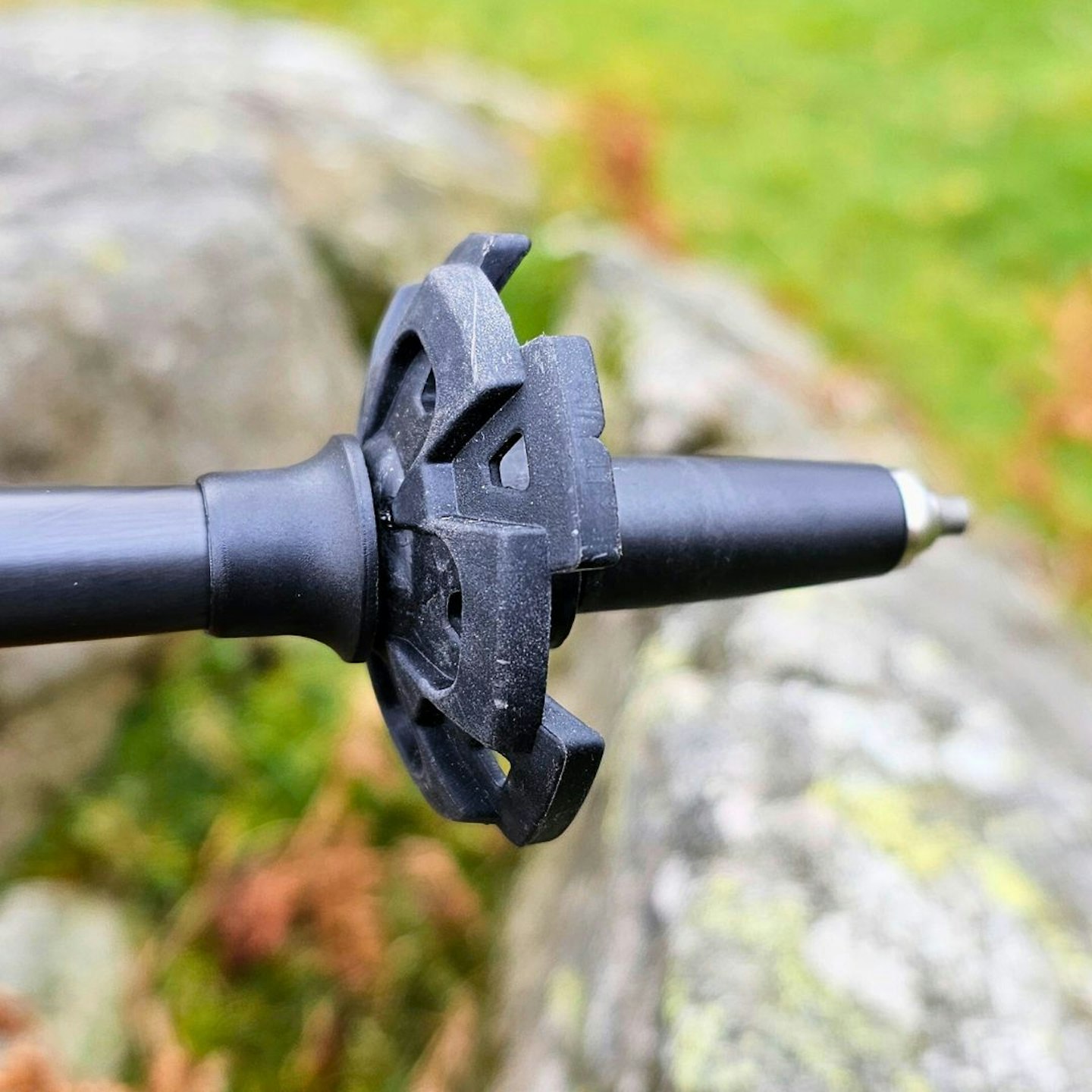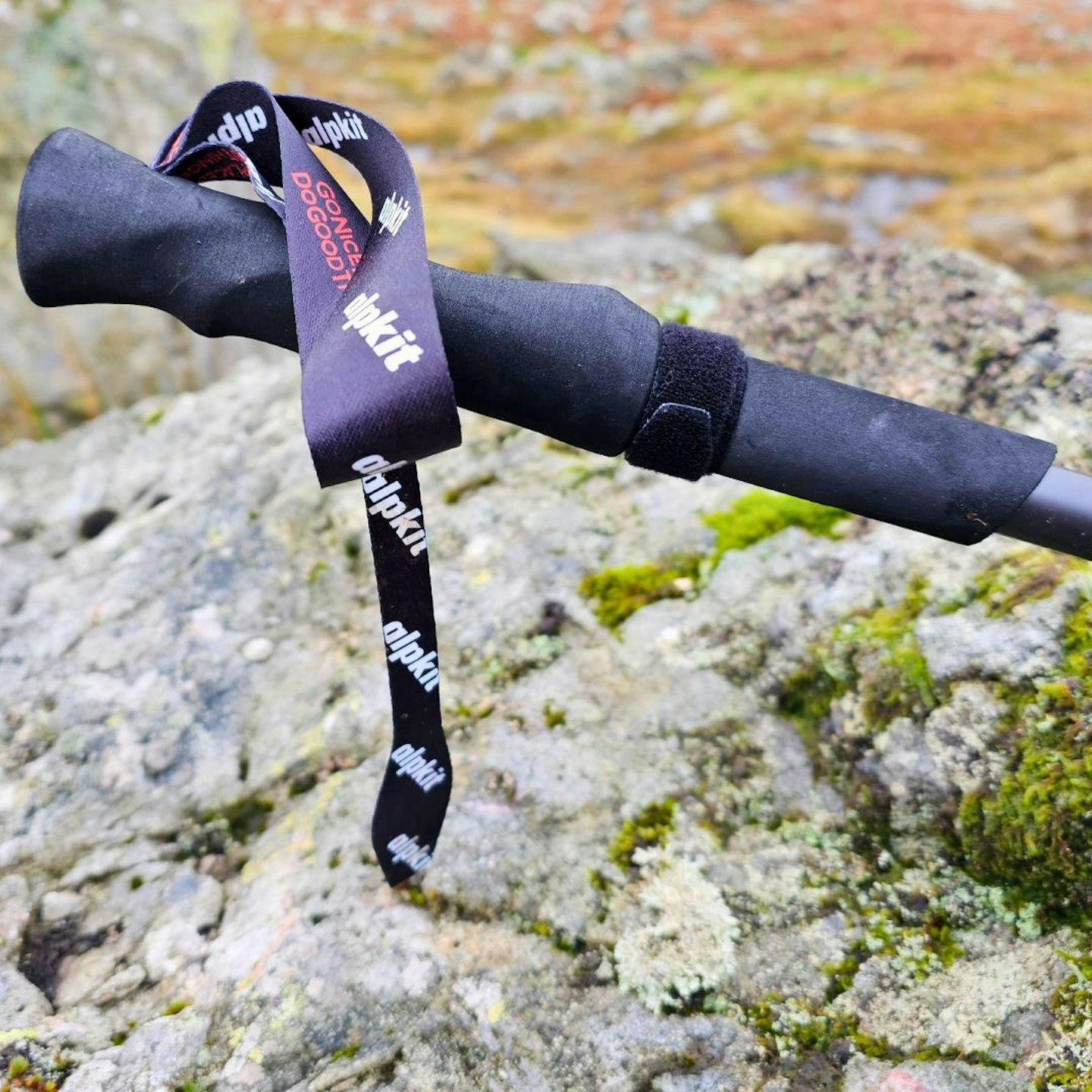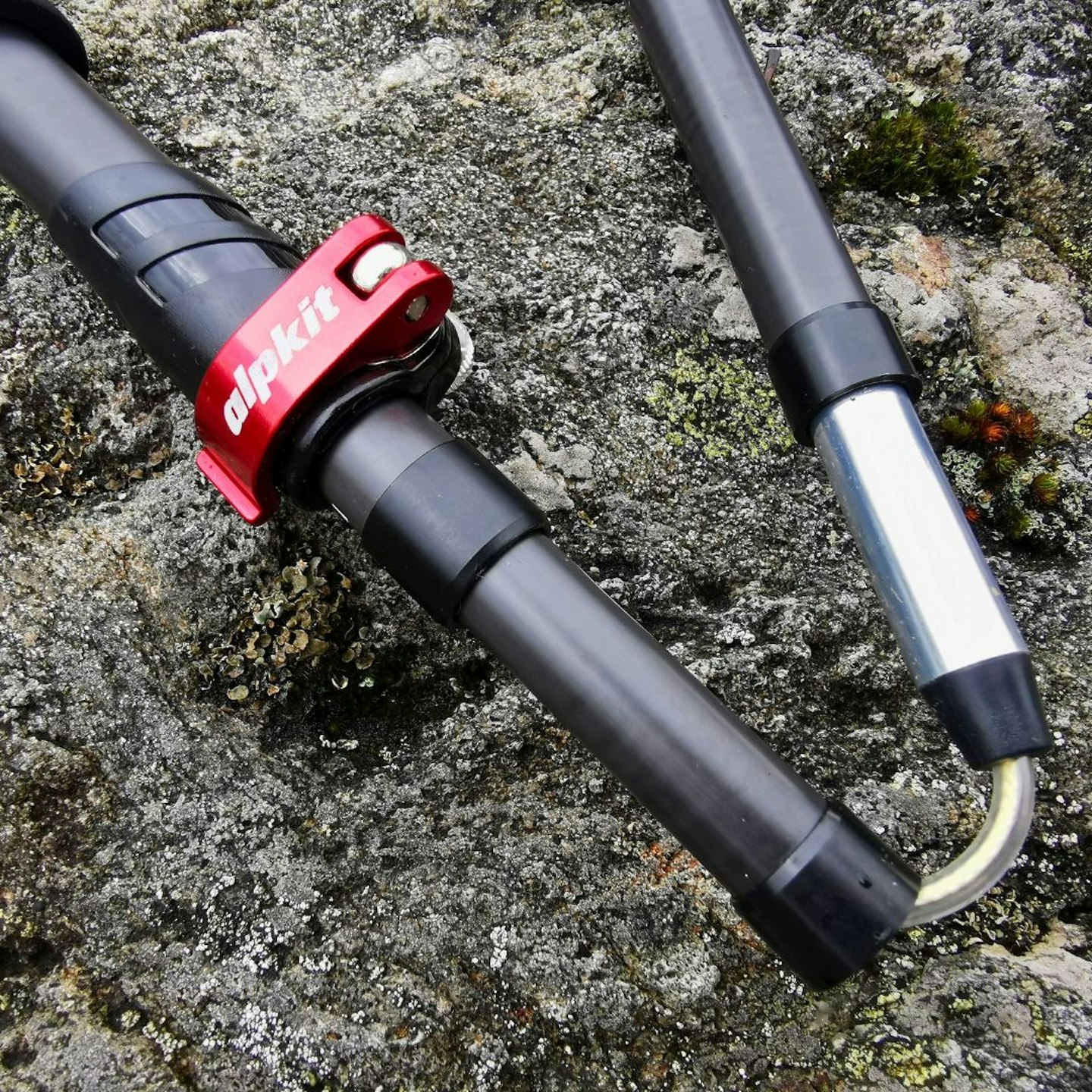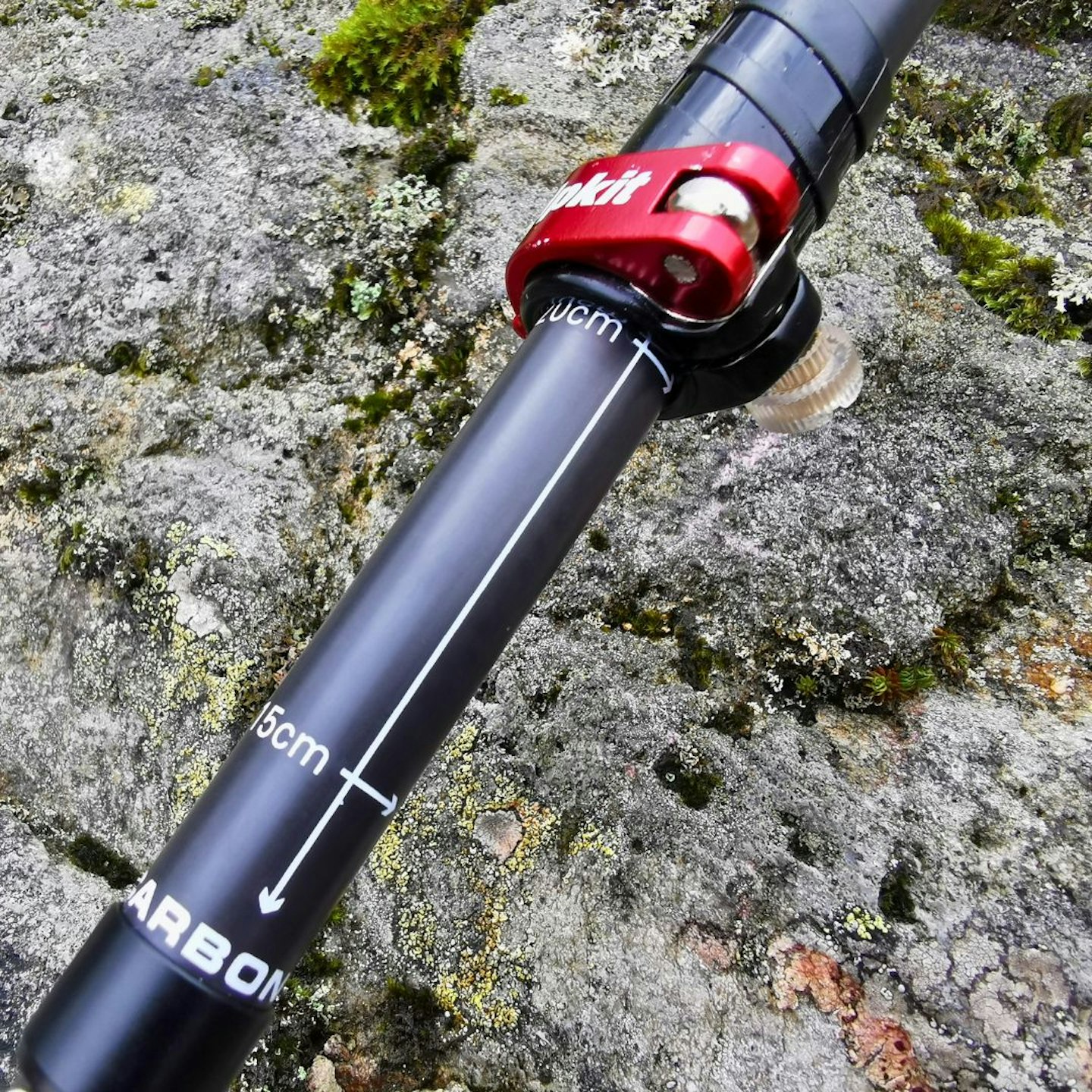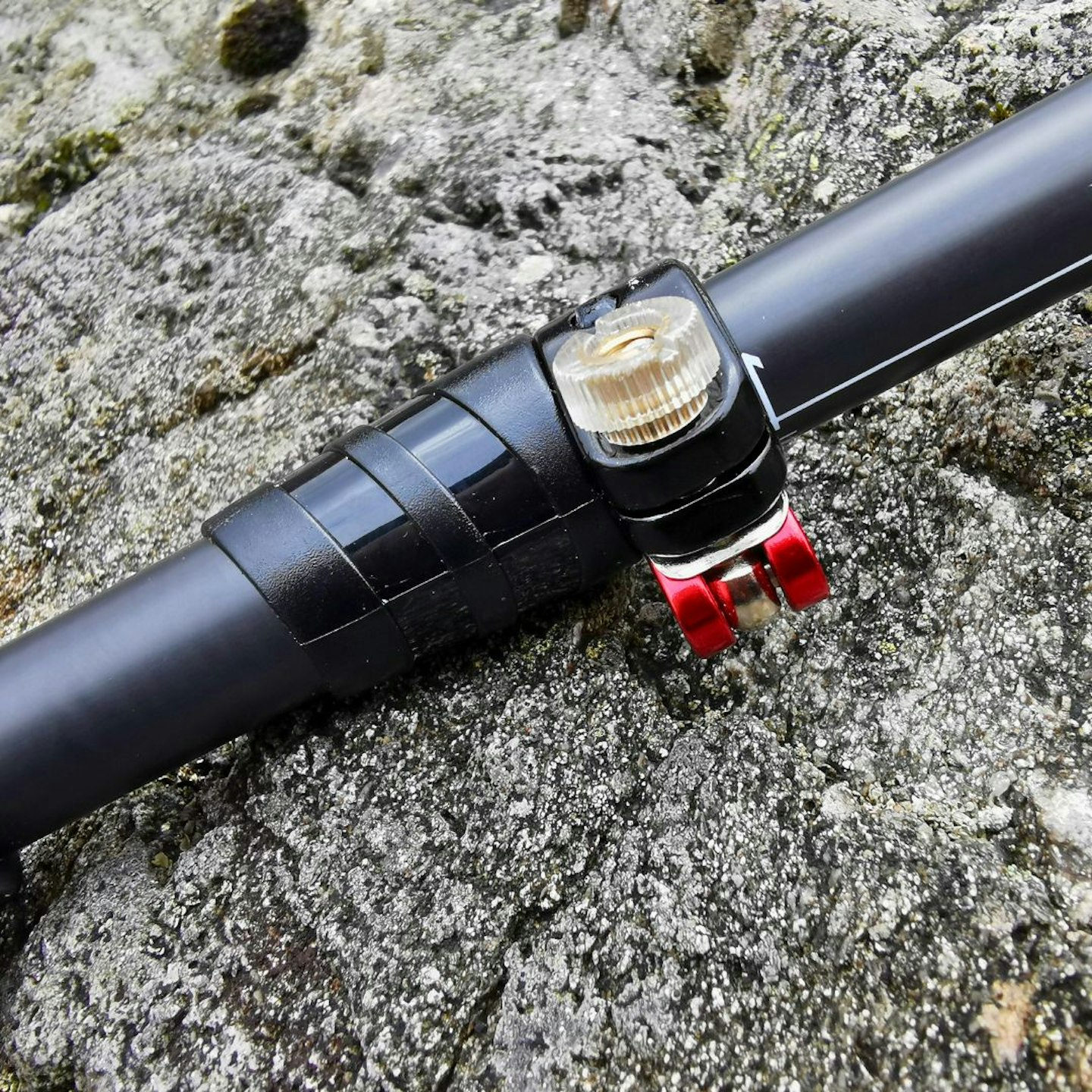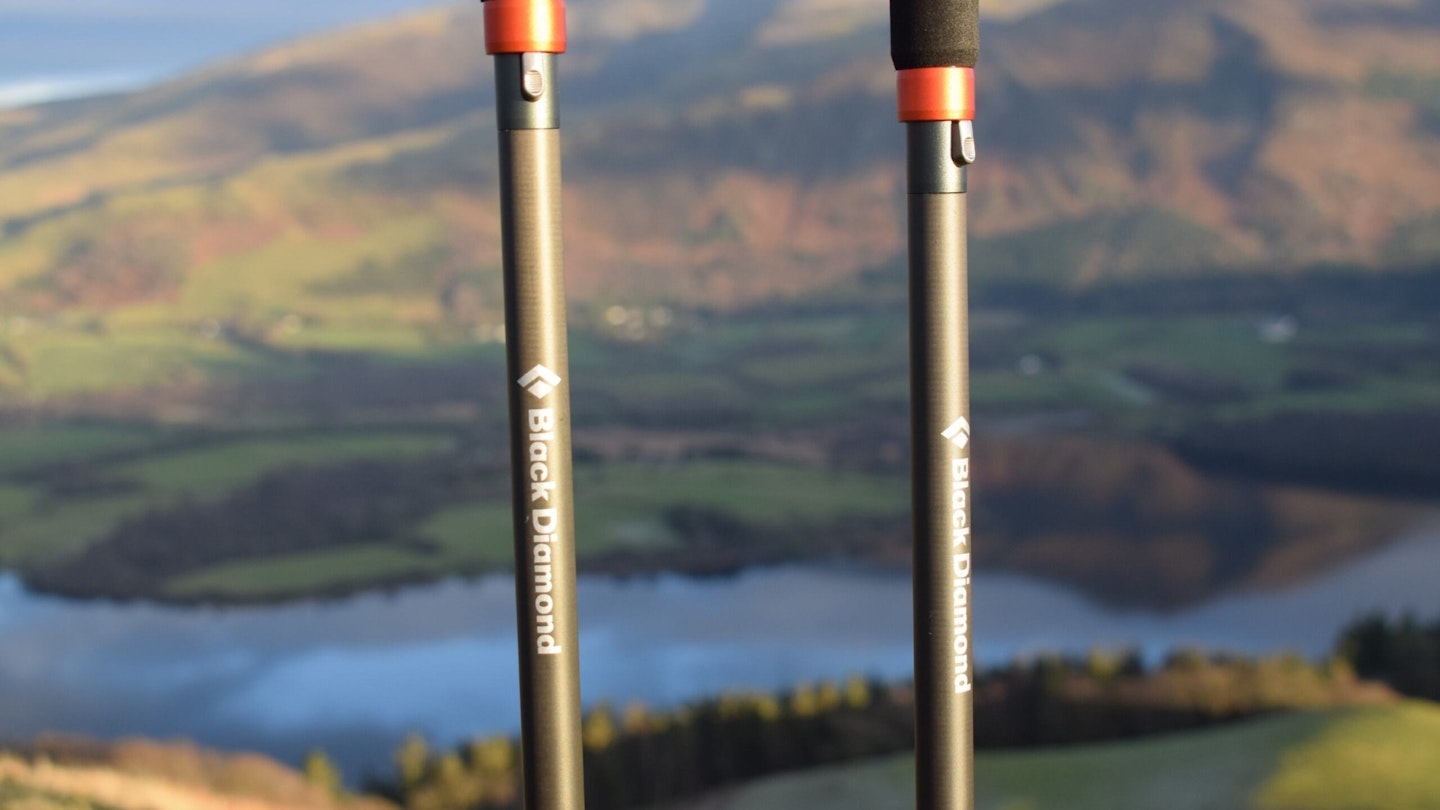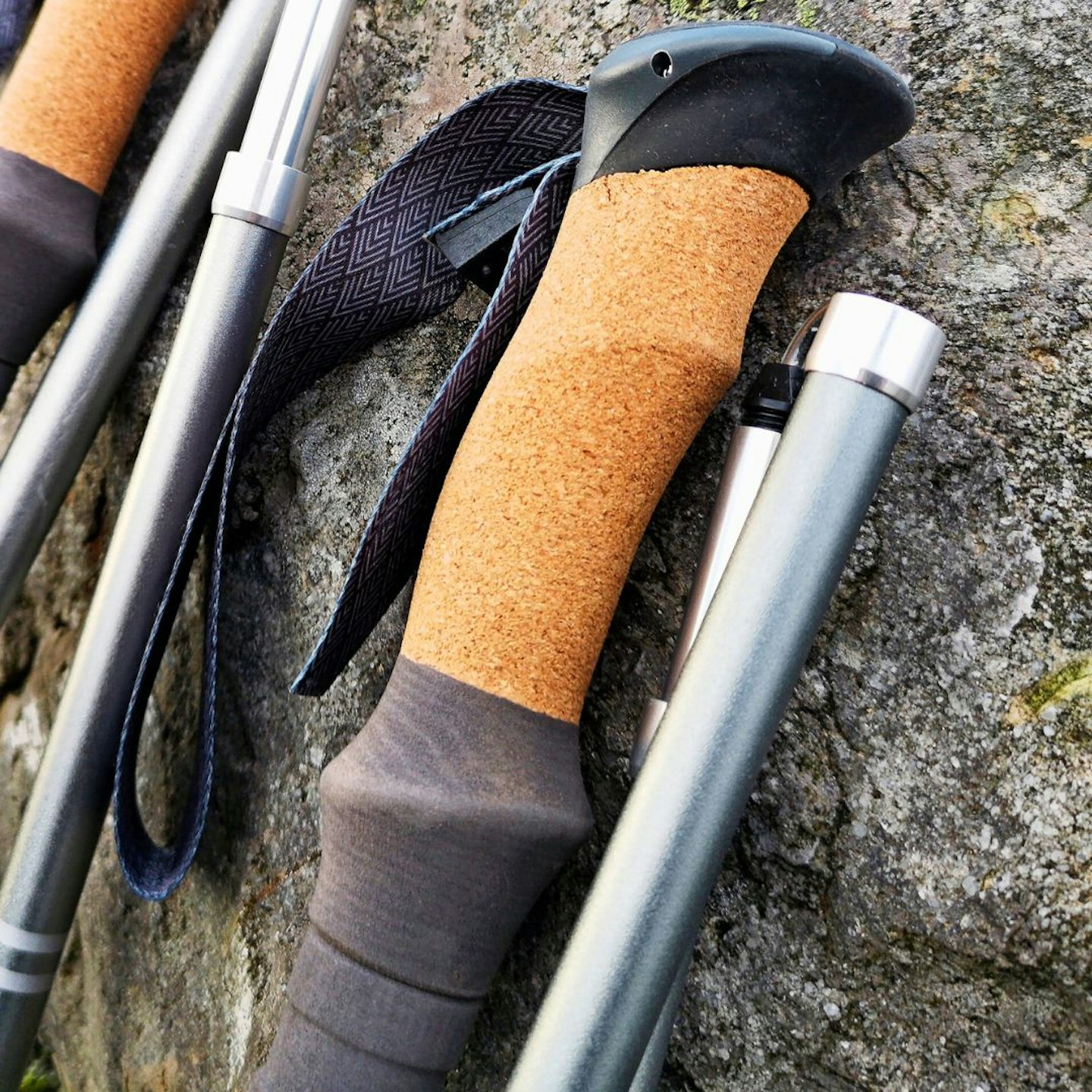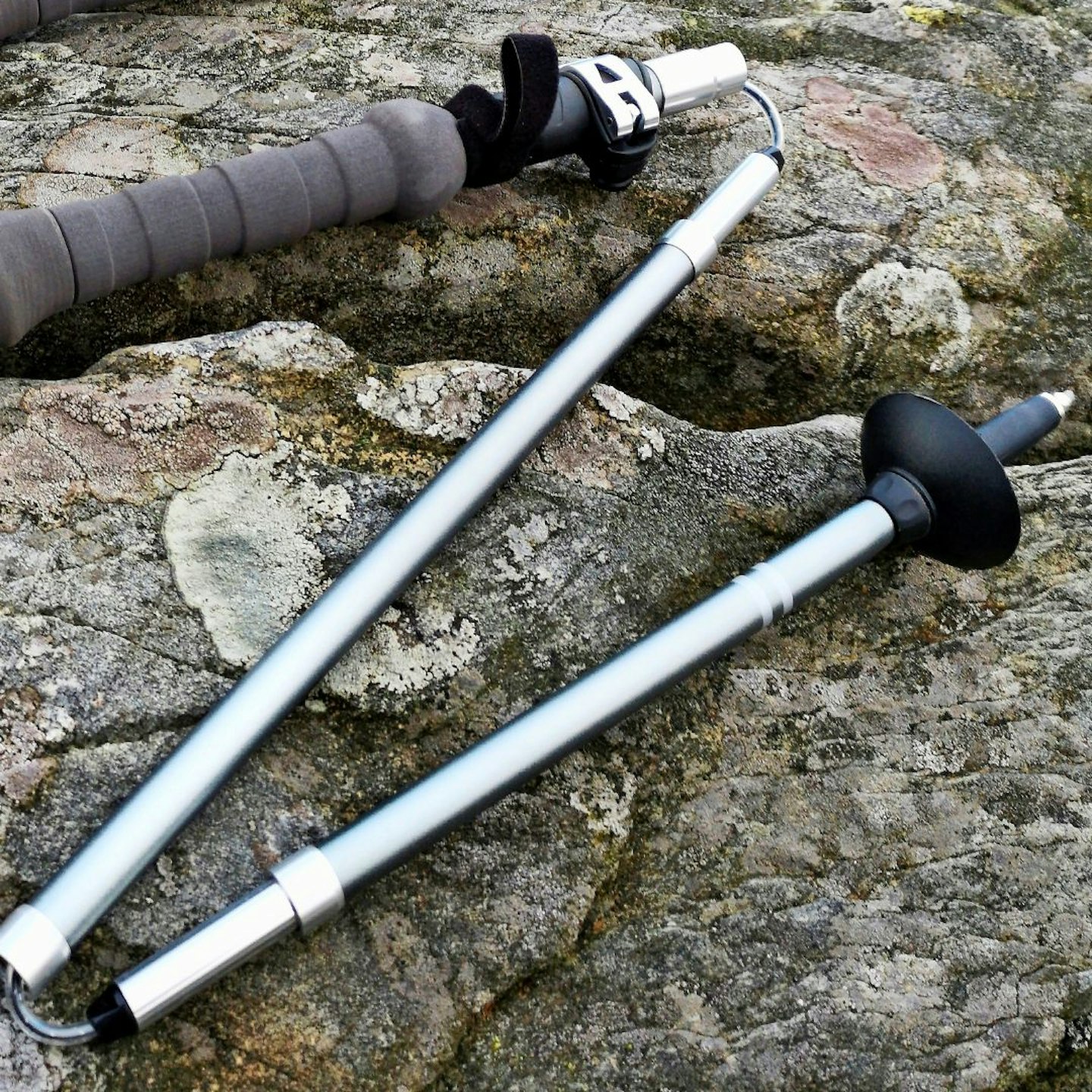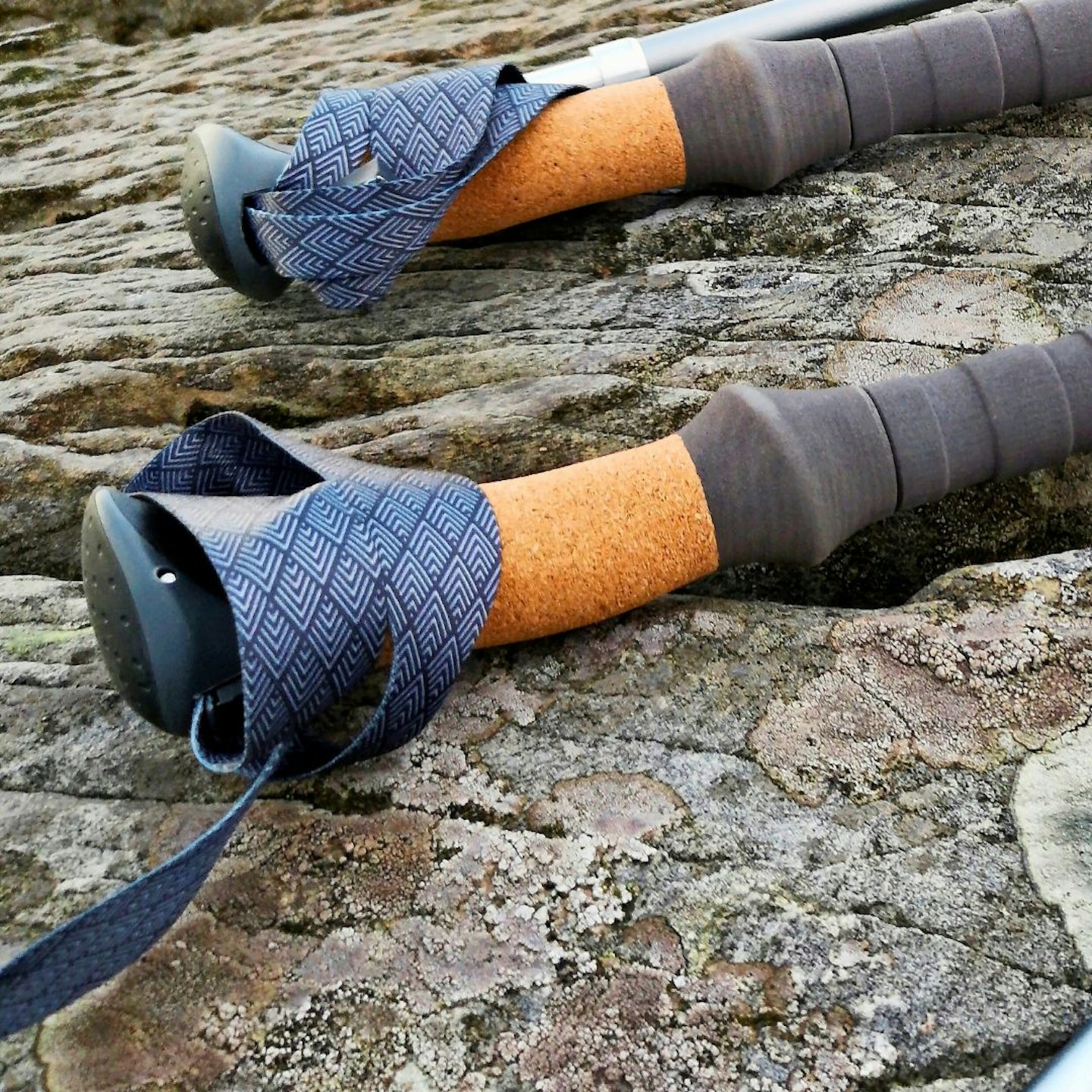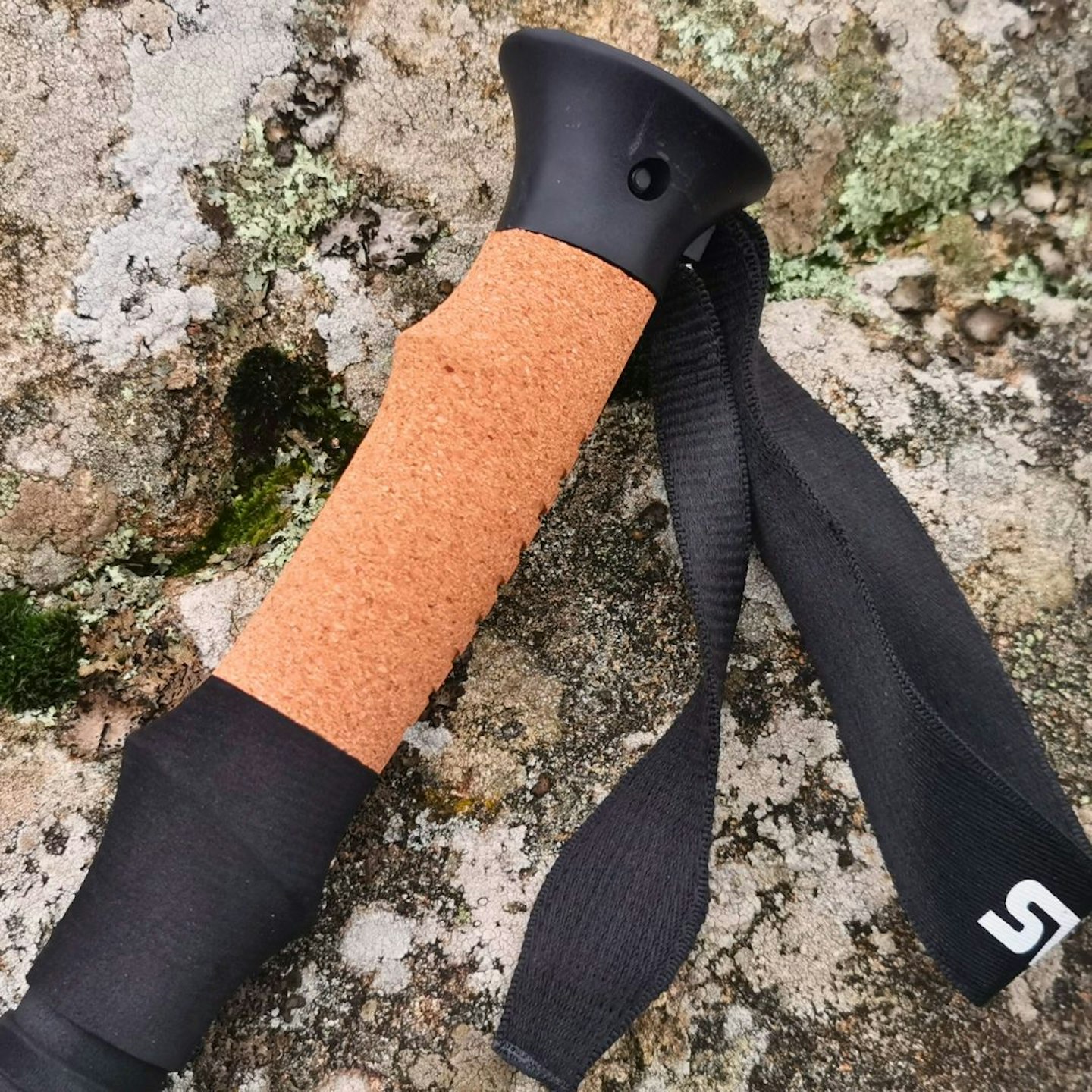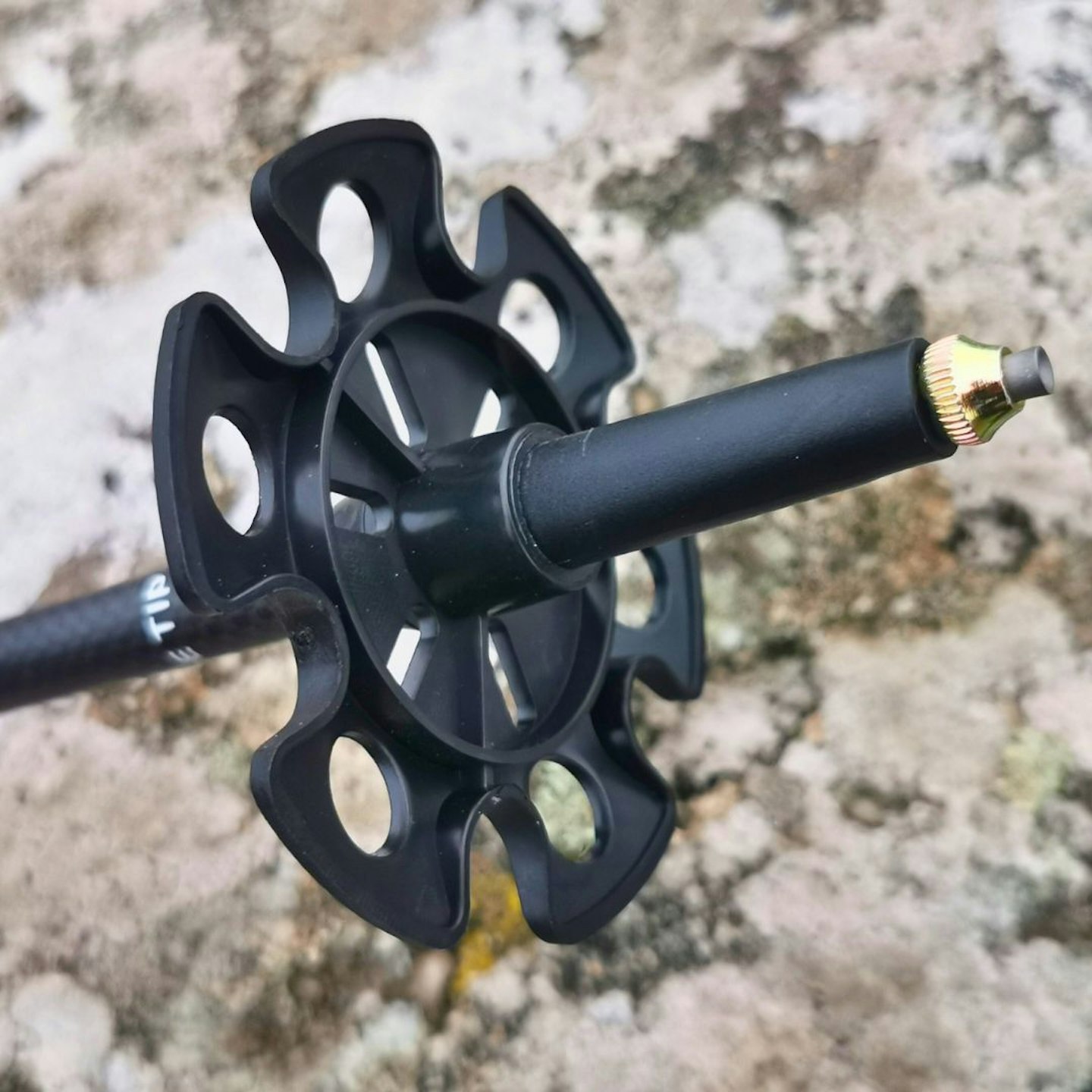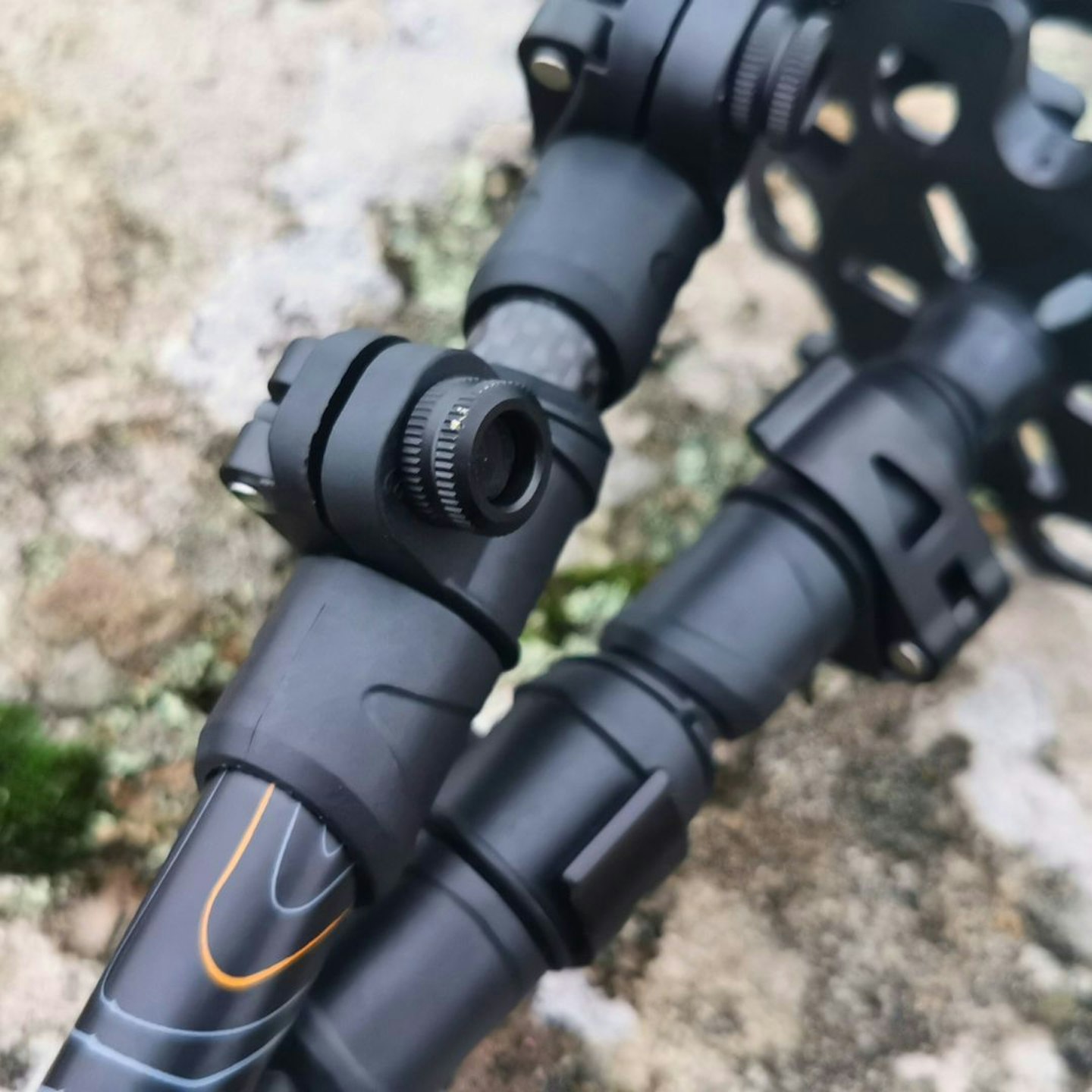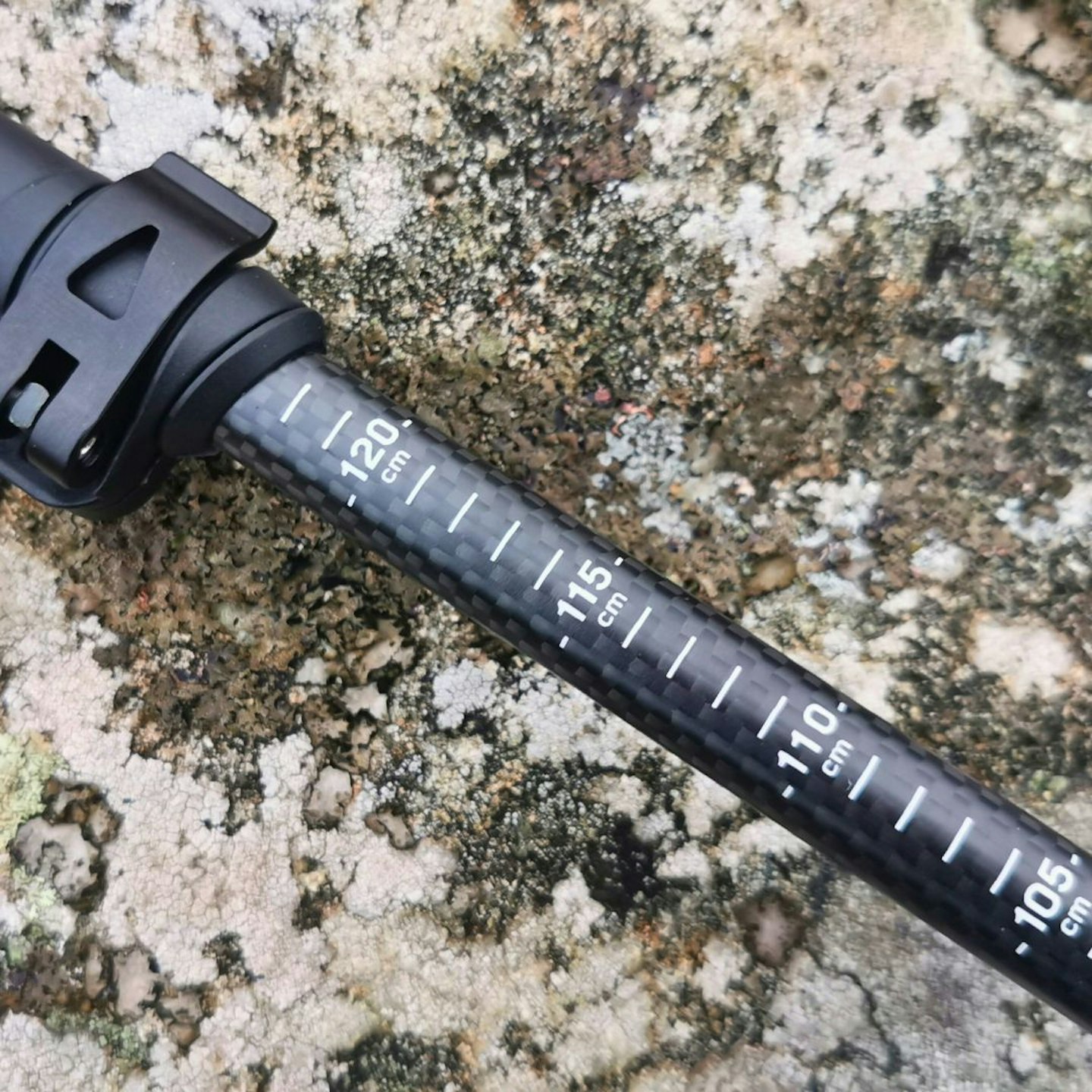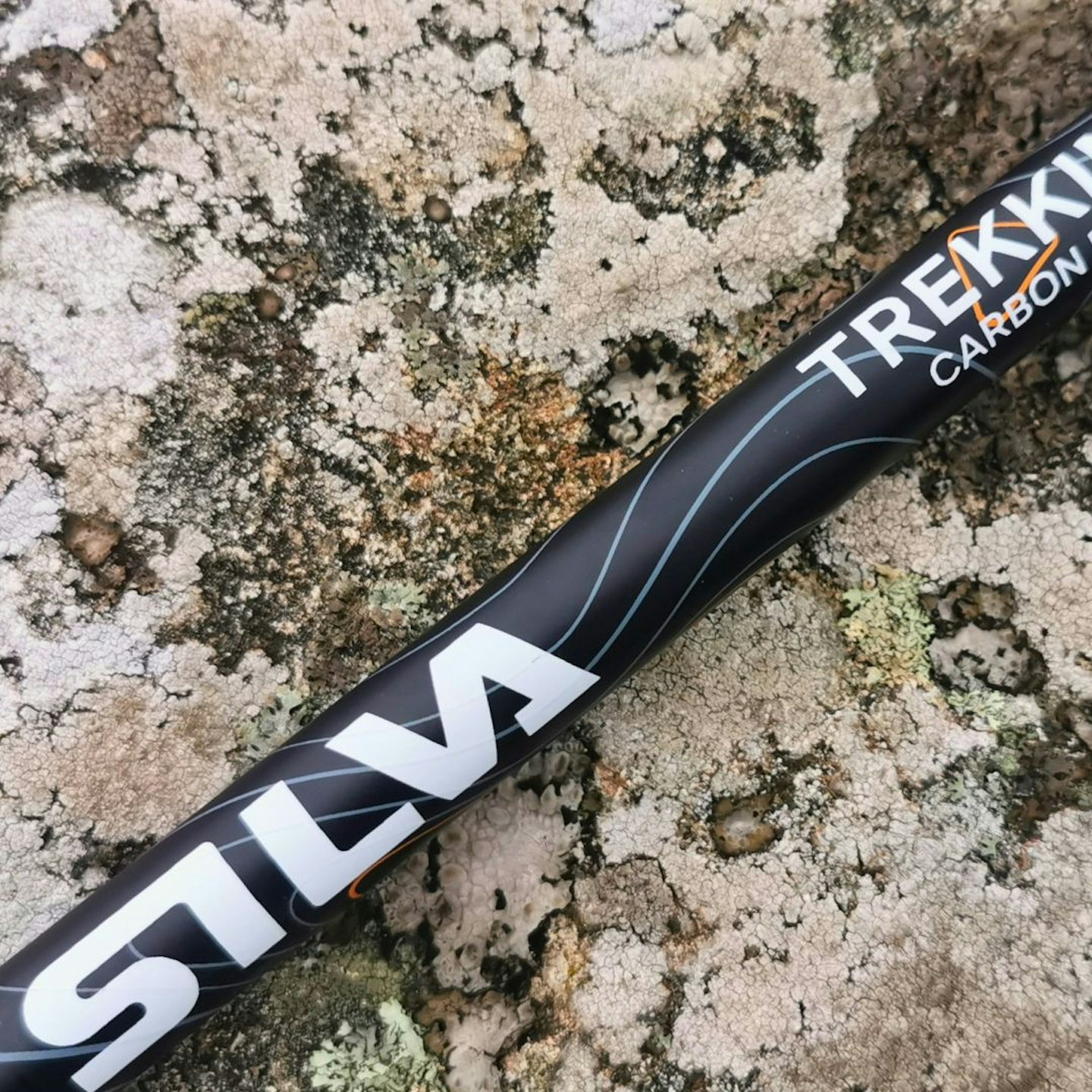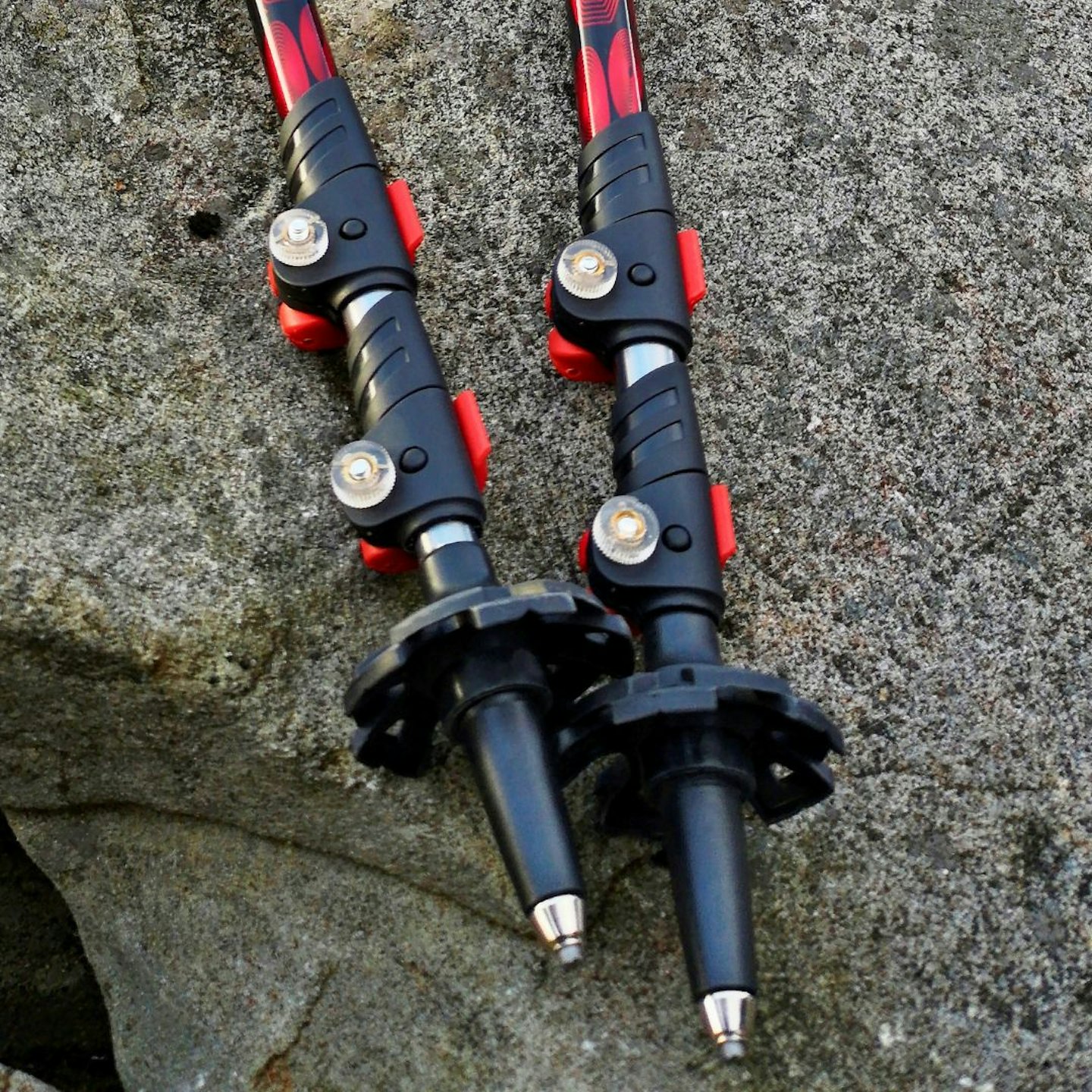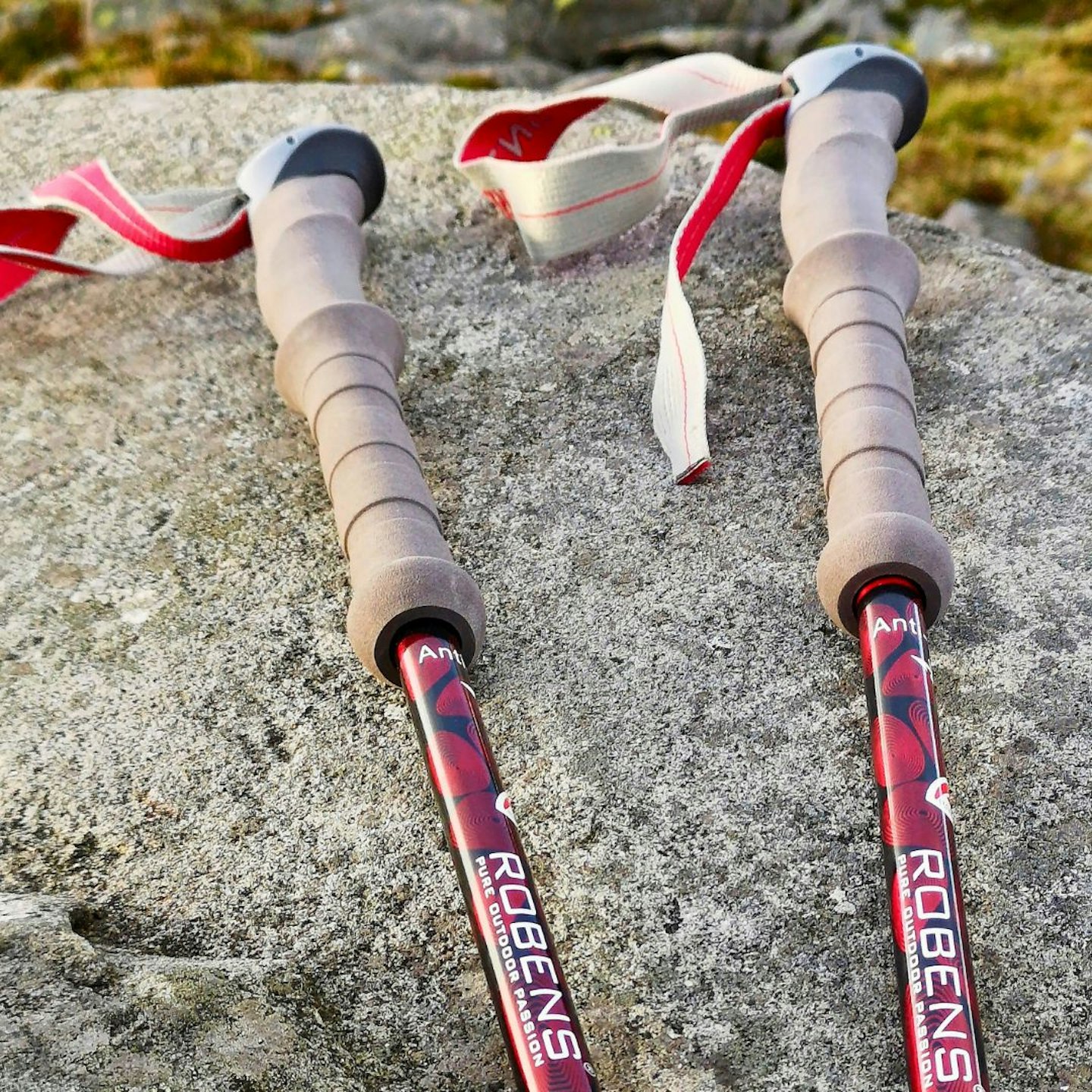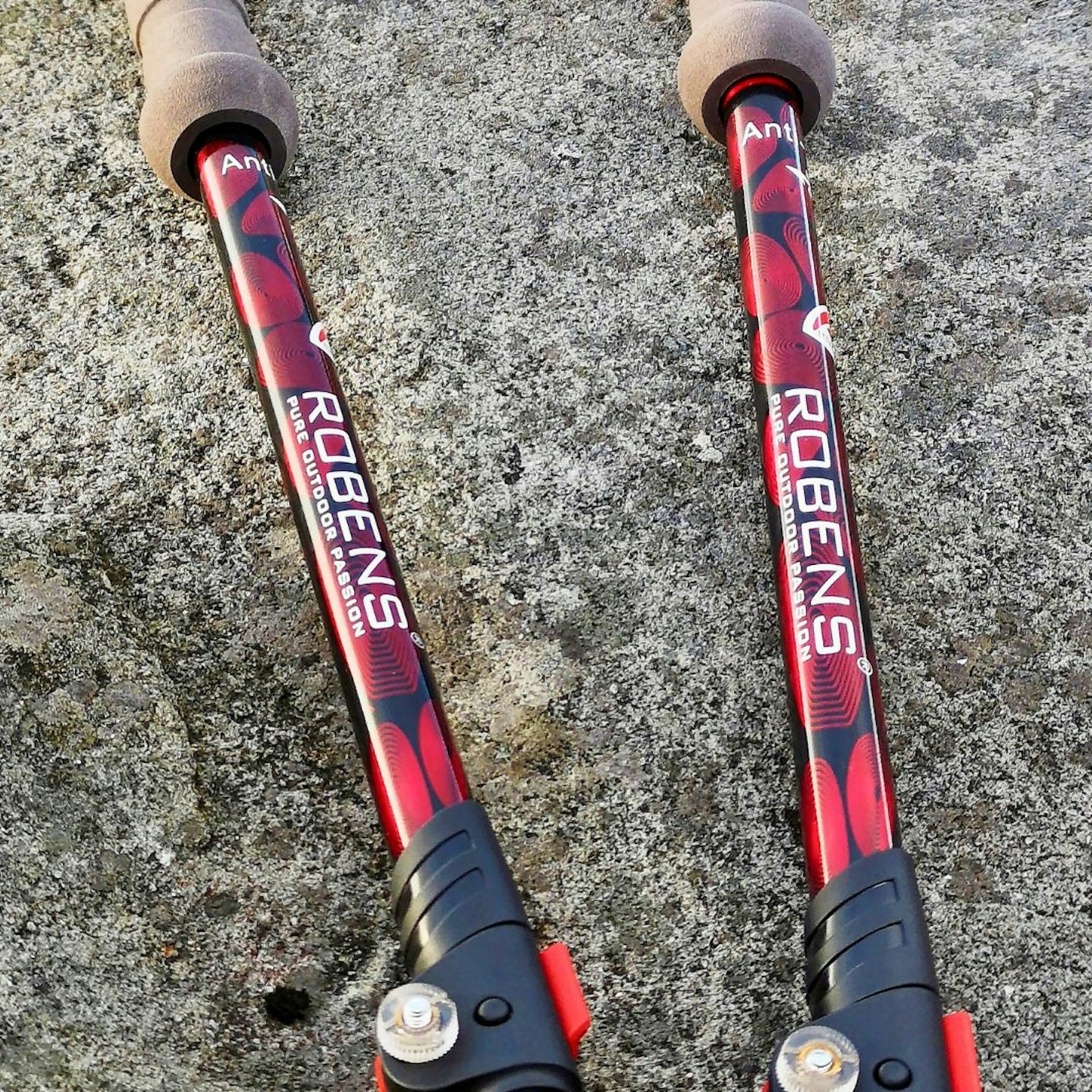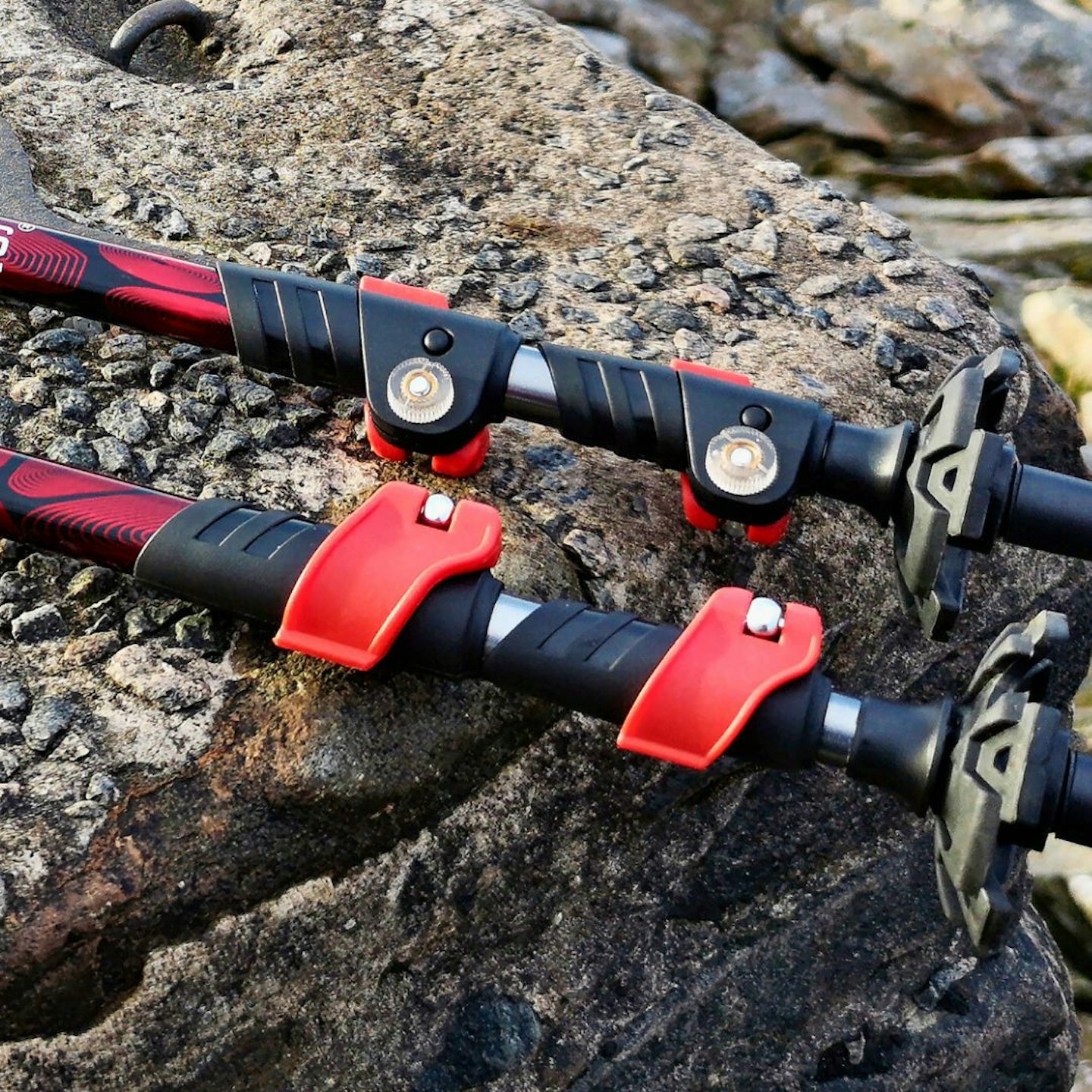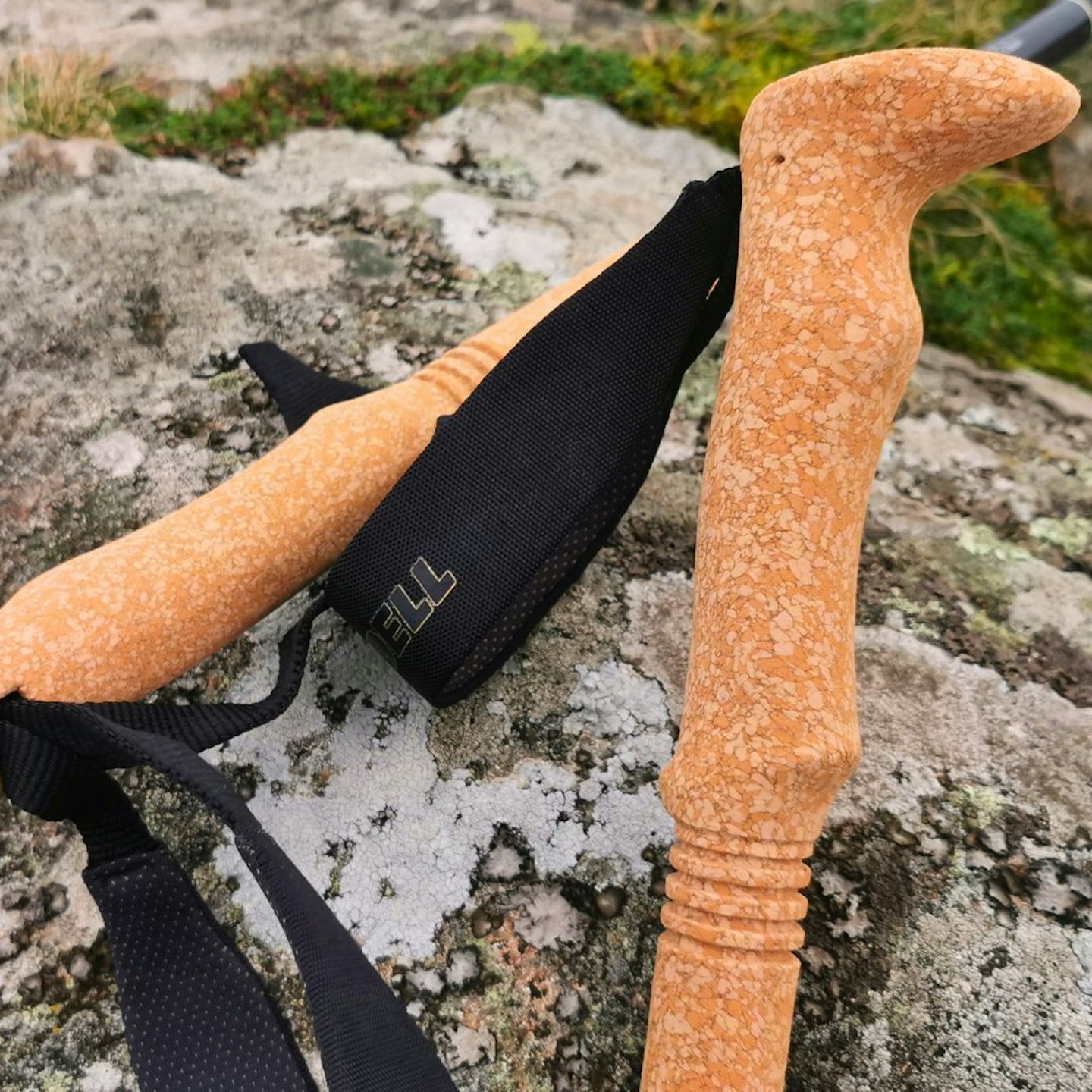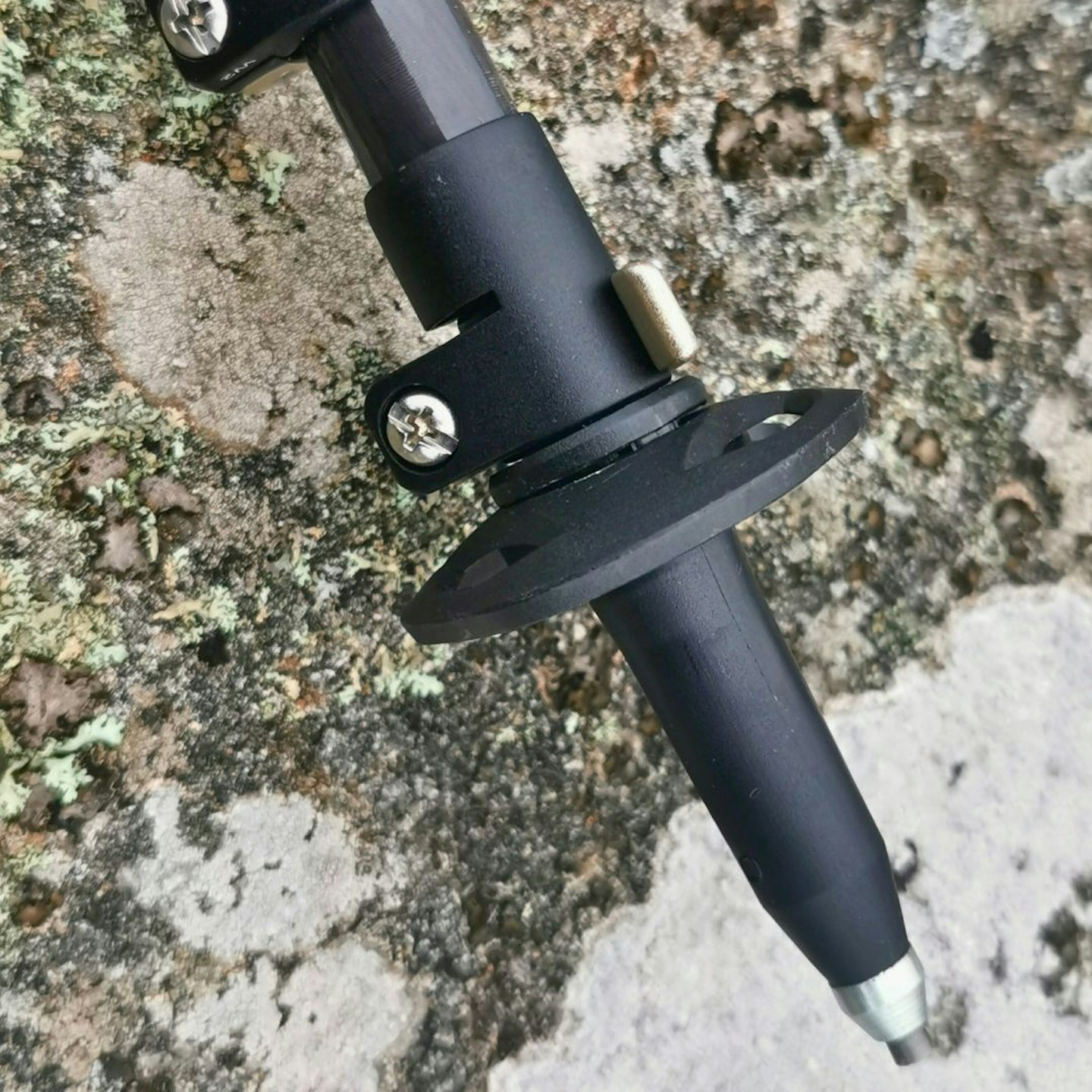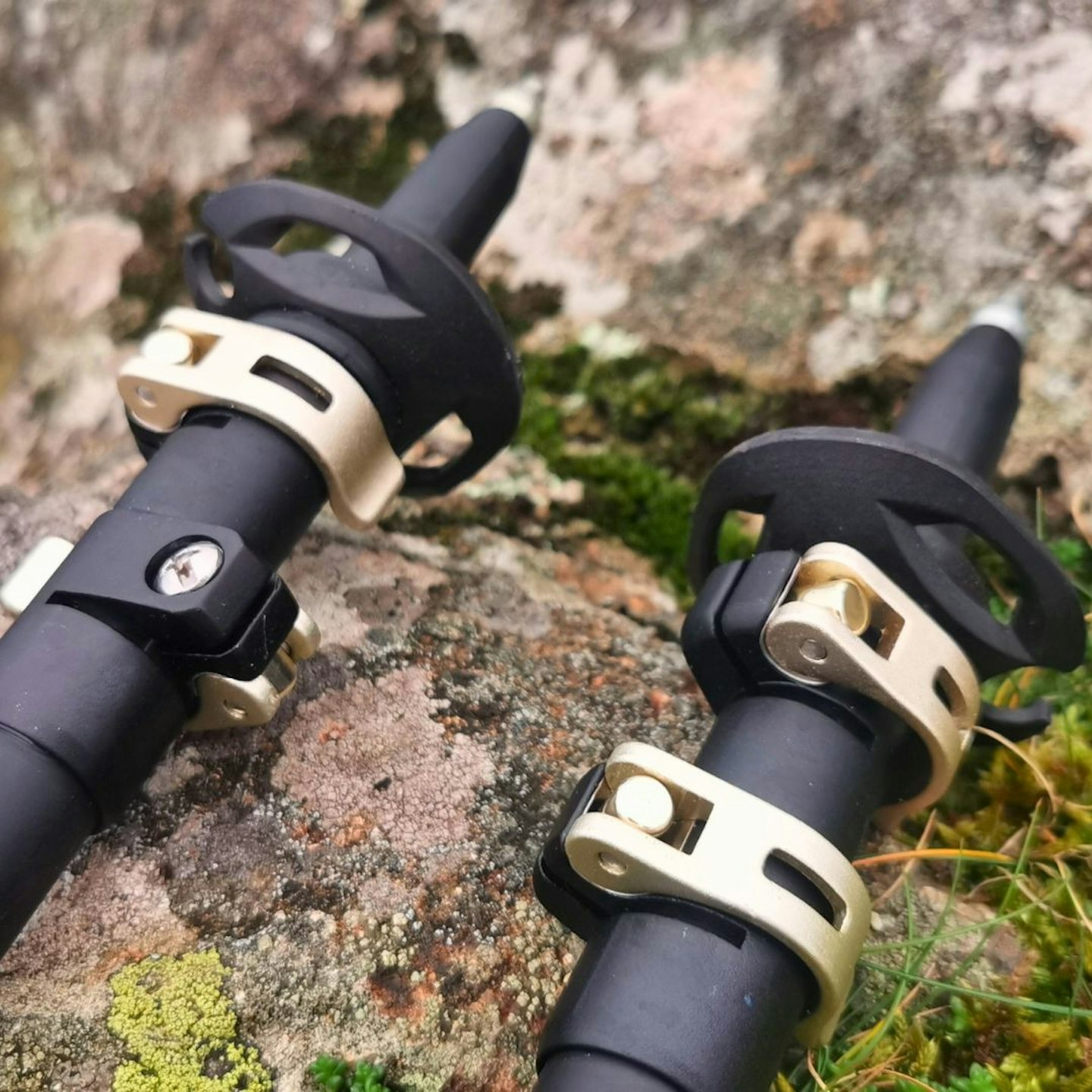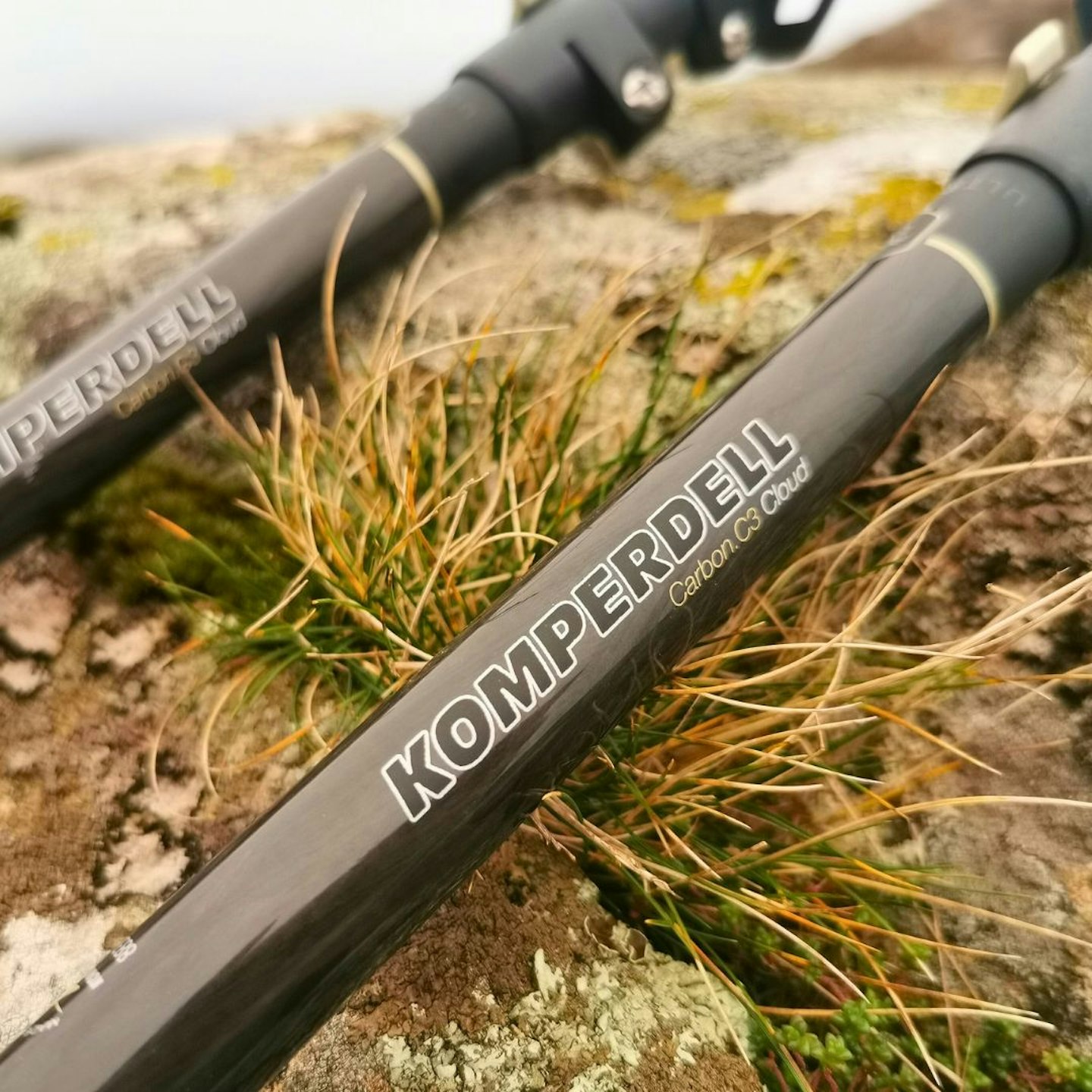Walking poles (often called trekking poles) assist with balance and stability on uneven terrain. They also help alleviate the strain suffered by your knees – experts estimate that when used properly, walking poles can take up to 30% of the weight off your lower joints.
That's a big plus on long, steep mountain days. And even for shorter walks, we're complete converts - they're an extremely useful part of your hiking kit.
Walking poles also reduce muscle damage, assist in maintaining muscle function in the days after a mountain trek, reduce the potential for subsequent injury, and can help with rhythm and cadence when you’re putting in big miles over the course of a long walk.
What are the best walking poles for 2025?
Best in test: Black Diamond Pursuit Trekking Poles
Highly recommended: Leki Cressida FX Carbon Lady
Best value: Alpkit Carbon Marathon Ultra Twins
Best walking poles under £40: Trekology Trek-Z 2.0 Cork Walking Poles
For all the reasons we've mentioned, most experienced long-distance hikers use walking poles. They're also increasingly popular for trail running. And if you’re backpacking or wild camping, the rise of ultralight trekking pole tents has added another reason to carry them, allowing you to ditch the deadweight of conventional tent poles by taking advantage of the poles you’re already carrying in your hands instead.
So, walking poles are a useful and versatile bit of kit in your backpacking arsenal, allowing you to go lighter and faster. If you’re tempted to try a pair – or if you’re already a convert but are looking for an upgrade – here are our top tested picks.
Editor's note: This article was fully updated in March 2025, with six new reviews added in following our latest round of testing.
How we tested the best walking poles

The walking poles recommended here were reviewed by two of regular gear testers Matt Jones and Ellie Clewlow, plus members of the wider LFTO team including Nick Hallisey (above) and Ben Weeks.
Based in Snowdonia National Park, Matt and Ellie are part of our primary gear testing team. Matt is the former editor of Walk and Scouting magazines, and the duo have walked several long-distance backpacking trails in New Zealand, the USA and throughout the UK.
On test, we use walking poles on a range of routes from short, sharp, technical routes, to longer hillwalks and big mountain outings. This way we get to know where they excel and where they don't. We also get a true sense of attributes such as build quality, comfort and ergonomics.
When testing these poles, our main criteria were: features, comfort, construction, performance and value. To break this down, we examined: adjustability and length, material, grip type, shock absorption, weight, tip type, straps and packability.
Read more about how we test here.
The best walking poles in detail
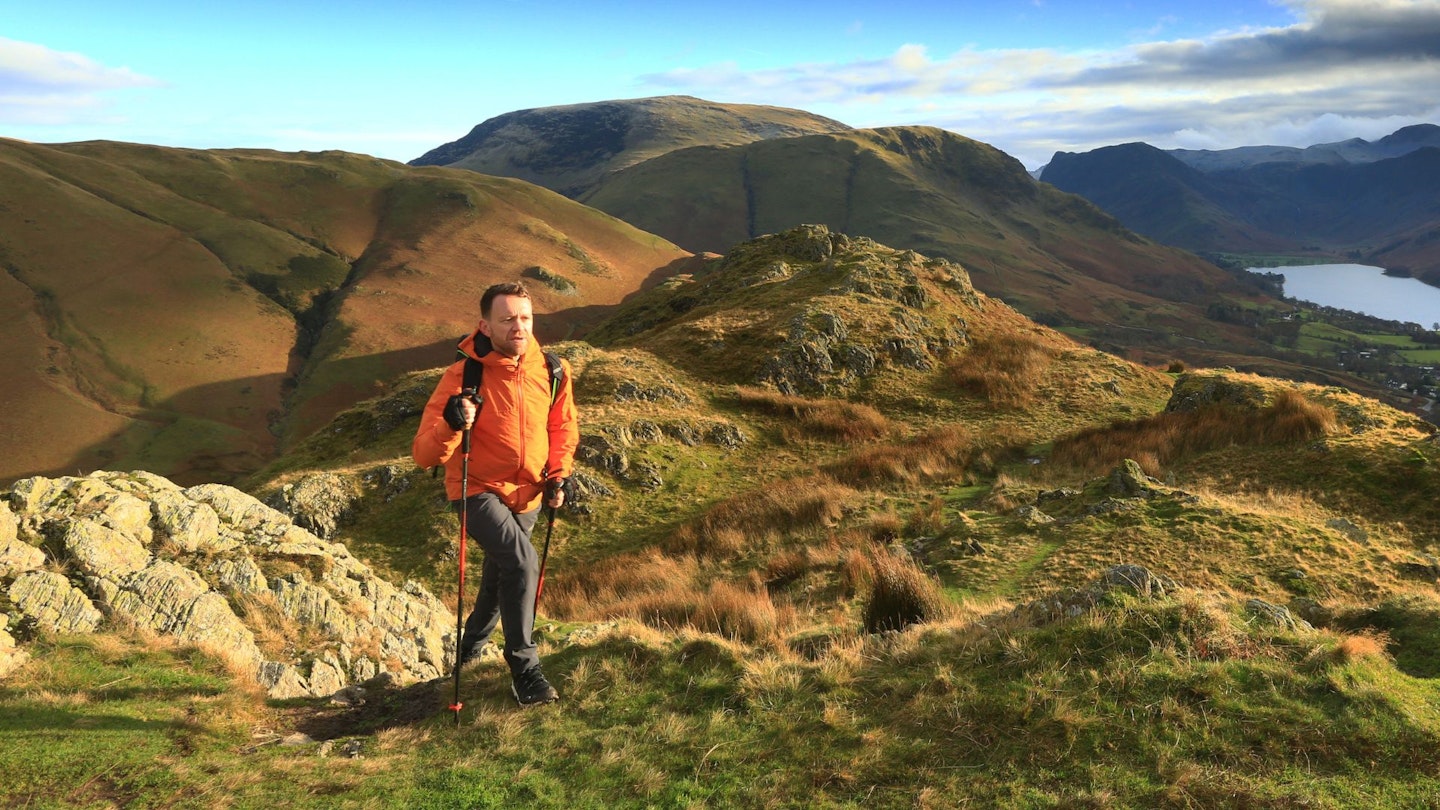
These are sturdy all-season trekking poles made from 7000-series aluminium alloy, with a three-piece construction. They feel comfortable and supportive – in fact, they were our favourite of all the poles on test in terms of comfort. And although they aren't the lightest or most compact, they are a solid choice for year-round use on mountain terrain and tough trails.
Black Diamond has had the sense to offer the Pursuit in two sizes, and better yet, the large size has larger grips for larger hands. The handles are made from natural cork with a lower section made from sustainable foam, derived from algal blooms.
The cork does a good job of absorbing sweat, while the foam extension allows you to choke down on the poles when ascending. The wrist straps are also made from recycled fabric and are well sculpted.
These poles are easy to adjust and feel very solid too, thanks to Black Diamond’s Flicklock Pro mechanism. We’ve previously criticised this system because it was only adjustable via a tiny Allen key, which made fine-tuning on the trail tricky.
Fortunately, Black Diamond has fixed this by including a 1.5mm Hex bit hidden inside the lower section of one pole – genius.
The lever locks also now have a soft-touch rubberised coating, which makes them easier to use with cold hands or bulky gloves. And you now get two sets of baskets supplied as standard: a smaller trekking set and a larger alpine/snow set. These are all worthwhile upgrades to what were already durable and dependable poles.
Pros
- Almost perfect comfort
- Durable and tough
- Two sets of baskets included
Cons
- Not the most compact or the lightest
| RRP: | £140 / $149.95 |
| Usable lengths: | 100 - 125cm (S/M), 100 - 140cm (M/L) |
| Collapsed length: | 58cm (S/M), 63cm (M/L) |
| Grip material: | Cork |
| Shaft material: | Aluminium |
| Weight (per pole): | 247g (S/M), 258g (M/L) |
These are top-end trekking poles made from premium grade performance racing carbon fibre. We tested the women’s-specific Cressida FX Carbon variant, while the men’s version is named the Makalu FX Carbon.
In use, they feel stiff and stable, yet very well-balanced in the hand. But their real benefits are in their speed and ease of use when it comes to deployment.
Both are Z-folding designs equipped with Leki’s innovative ELD folding system. You can basically just shake out each pole and pull the top section until it clicks, locking each section securely in place via precision aluminium collars and a plastic-sheathed internal cord. Disassembly is just as easy.
The five-section construction ensures they have an extremely compact folded length too. They’re short enough to stash inside a daysack and come with a neat storage bag. Other features include Aergon Air grips, with a rubberised head, contoured cork handles and cutaway sections to reduce weight.
We found them ideal for mountain routes that include a mix of terrain like pole-friendly paths plus steeper, hands-on scrambles.
Check out the men'sMakalu FX Carbon Poleshere.
Pros
- Super lightweight
- Very easy to deploy and pack away
- Great on mixed terrain mountain routes
- Compact
Cons
- Over-engineered for most people
| RRP: | £200 / $229.95 |
| Usable lengths: | 100 - 120cm (110 - 130cm for Makalu FX Men) |
| Collapsed length: | 40cm |
| Grip material: | Aergon Air cork |
| Shaft material: | Carbon fibre |
| Weight (per pole): | 245g / 8.6oz |
These are great value carbon fibre trekking poles, with a considered design and high-quality materials that defy their reasonable price tag. We used and carried them on several big days in the hills with no dramas.
They use a three-section, Z-folding construction with EVA foam rubber grips and woven fabric wrist straps. The internal tensioning cord is sheathed in protective plastic, while the inner ferrules and lever-lock clamps are made from durable aluminium.
Tension does rely on a single button lock, but it seems secure. As with most poles, the tips are tungsten with screw-in trekking baskets. It’s all relatively simple but effective, and they proved to be reliable performers for us.
They’re lightweight and extremely packable, with the shortest folded length of any poles on test. This ensures they stash easily into a small daypack. But the maximum extended length is only 130cm, which isn't ideal for tall hikers, so we'd happily trade some compactness for more length.
We also like the integrated Velcro straps in the handle, which keep the folded sections together very neatly when not in use.
Although reasonably basic, for 3-season hiking and long distance backpacking we happily back these. In fact, one of our testers has an older twist-lock set of Alpkit Carbon Ultras that have done several hundred miles and are still going strong.
Pros
- Great value for carbon fibre poles
- Excellent for general hiking use and backpacking
- Very compact
Cons
- Not quite long enough for tall hikers
- Quite basic
| RRP: | £89.99 / $119.99 |
| Usable lengths: | 110 - 130cm |
| Collapsed length: | 37cm |
| Grip material: | EVA foam |
| Shaft material: | Carbon fibre |
| Weight (per pole): | 205g / 7.2oz |
The Black Diamond Pursuit Carbon Z is a premium, fixed-length trekking pole designed for performance-driven hikers.
Similar to its aluminium brother further up this list, it features a Z-shaped design that folds into a compact 40cm, making it highly portable. The pole uses Black Diamond's "Z-Pole Rapid Deployment System," which allows for effortless deployment and collapse via an inner cord and push-button mechanism.
Weighing 208g per pole, it is light but not ultralight, especially for its £170 price tag. While the fixed-length design simplifies use, it lacks adjustability, which could be a drawback for some users who prefer customisation for different terrain.
However, we did like that its simplicity reduces potential points of failure. The ergonomic cork and EVA foam grip, ultralight mesh leashes, and carbide tips all contribute to comfort and durability.
Overall, the Pursuit Carbon Z offers excellent build quality, though its construction and price may not appeal to everyone.
Read our full Black Diamond Pursuit Carbon Z Trekking Poles review.
Pros
- Excellent features
- Rapid deployment
- Automatic collapsing
- Excellent portability
Cons
- Non-adjustable
- Slightly heavy for the price
- Expensive
| RRP: | £170 / $199.95 |
| Length: | 40cm |
| Adjustability: | None, fixed length only |
| Weight (per pole): | 209g / 7.4oz (120cm) |
| Shaft material: | Carbon |
These poles from relative newcomer Oregon-based Trekology have a very clear focus on value. Sure, these walking poles are very well priced but crucially, we found they're very decent. Somewhat predictably, the finish doesn’t quite match the more established brands, but the materials and construction are high-quality. Certainly far better than other cheap rivals.
The four-piece shaft is made from 7075 aluminium alloy, connected via an internal cord with a protective plastic sheath. A lever lock enables a wide range of adjustment, employing a plastic collar with a metal clamp.
At one end of the pole, you get a comfortable cork grip with an EVA foam extension and a simple fabric wrist strap. At the other is a tungsten carbide tip with a removable plastic trekking basket.
And despite their low cost, these poles come with two sets of baskets. Really, the only quibbles we had on test were that they're not the quickest to deploy, since the telescopic section partway up the shaft needs to be extended to lock the pole tension, which isn’t immediately obvious. And at 300g each, they're relatively heavy.
Pros
- Incredible value
- Two sizes available
- Robust for cheaper walking poles
- Compact
Cons
- Not the fastest to deploy
- Relatively heavier
| RRP: | £33.99 |
| Usable lengths: | 100 - 120cm (short), 115 - 135cm (tall) |
| Collapsed length: | 38cm |
| Grip material: | EVA foam |
| Shaft material: | Aluminium |
| Weight (per pole): | 294g / 10.4oz (short), 306g / 10.8oz (tall) |
The Fizan Compact trekking pole is a standout for its ultralight weight of just 169g per pole, making it the lightest we've tested in recent years, all while maintaining an affordable £70 ($87) price tag.
Unlike most ultralight poles, which are made from carbon fibre, the Fizan is made from aluminium 7001. It feels sturdy enough but the pole features a twist-lock adjustment system, which, while initially secure, is prone to potential long-term failure due to dirt and wear.
The pole’s length adjusts from 100cm to 132cm, and has a packed size of 60cm, which is relatively large compared to Z-folding poles.
We found the foam grip comfortable, though it lacks an extended section. The wrist leash and carbide tips perform well, ensuring good traction.
Overall, the Fizan Compact is an excellent choice for budget-conscious, weight-conscious hikers, though the twist-lock system’s longevity remains a concern.
See our full Fizan Compact Trekking Poles review for more.
Pros
- Affordable
- Great value
- Ultralight
- Good features
Cons
- Twist-lock system
- Quite long at 60cm, not the most portable
- No extended grip, hand grip only suitable for small hands
- Questions over long-term durability
| RRP: | £70 / $87.10 (pair) |
| Length (folded): | 60cm |
| Adjustability: | 100-132cm |
| Weight (per pole): | 169g / 5.9oz |
| Shaft material: | Aluminium |
These are some of the stiffest carbon fibre poles we’ve tested, with thicker diameter shafts that feel very sturdy. They are solid and well-balanced. However, they’re still commendably light, tipping the scales at precisely 200g per pole.
They’re a three-section telescopic construction with an excellent range of adjustment via twin flick locks. The levers can be hand-tightened via a dial, requiring no tools, unlike some rivals.
Measurements are also clearly marked on each pole section, making them easier to adjust in the field, though the flick-locks add a little bulk and seem slightly more prone to getting knocked about or clogged with dirt. Still, we experienced no issues on test.
But we had differing opinions on the comfort of the handles. They're a chunky mix of cork and foam, which Matt liked very much, but they were a bit too big for Ellie’s smaller hands to grasp comfortably.
And speaking of oversized, the supplied baskets are also very large – ideal for deep mud and snow, but a bit unwieldy for general trail use. Nor are the Silva Trekking Poles Carbon the most compact walking poles, but that solidity-compact trade-off is to be expected.
Pros
- Tough and durable
- Easy to adjust
- Supplied baskets good for snow and mud
- Good adjustment range
Cons
- Large handles don't suit small hands
- Not the most compact
| RRP: | £119.99 |
| Usable lengths | 110 - 140cm |
| Collapsed length | 67cm |
| Grip material | Cork |
| Shaft material | Carbon fibre |
| Weight (per pole) | 200g / 7.1oz |
The Lomo Aluminium Walking Poles are an impressive bargain at just £29 ($36) for a pair, offering good value for money despite some trade-offs in quality we found.
Made entirely from aluminium, these poles feature a three-segment, telescopic design secured by lever clamps for adjustability between 100cm and 135cm. While they offer solid strength and durability, they weigh a moderate 248g per pole—too heavy for some hikers but sturdy for others.
Their 63cm collapsed length makes them less portable than some, which could be a downside for those seeking compact gear. Nevertheless, they come with useful features, such as adjustable wrist leashes, trekking and snow baskets, tungsten pole tips, and EVA foam grips.
These components perform adequately, though we think they feel basic compared to higher-end models. While some may find the design a bit clunky, for the price, the Lomo poles are a steal for those prioritising cost over premium features.
Read our full Lomo Aluminium Walking Poles review for more.
Pros
- Unrivalled value
- Real bargain
- Good features for the price
- Broad adjustability range
- Feels tough and sturdy
Cons
- Not compact or portable
- Too long when collapsed down
- Heavy
- Cheap components
- Extended grip could be longer
| RRP: | £29 / $36 |
| Length (folded): | 63cm |
| Adjustability: | 100-135cm |
| Weight (per pole): | 248g / 8.8oz |
| Shaft material: | Aluminium |
These trekking poles are relatively inexpensive, but don’t skimp on design or materials. The shafts are made from high-quality 7075 grade aluminium alloy, with extended EVA foam rubber grips and fabric wrist straps.
The top of the handle is a softer rubber rather than a hard plastic. They have a switchable anti-shock system that is turned on or off with a quick twist. The poles have a wide range of adjustment too, ensuring one size fits most.
The three-piece telescopic design employs modern lever locks rather than the older-style twist-lock system. The locking pins are metal, but the collars and clamps are plastic, while the tips are tungsten carbide with screw-in baskets. They’re also supplied with a carry bag.
They’re not the lightest walking poles, but don’t feel too unwieldy either. We've come to happily trust them long-distance trips or big hillwalking days. However, they're not very compact, with their 65cm collapsed length sometimes making them awkward to attach to a daypack.
Pros
- Good value
- Durable materials used
- Bag supplied
Cons
- Tad heavy
- Not very compact
| RRP: | £55 (pair) |
| Usable lengths | 65 - 135cm |
| Collapsed length | 65cm |
| Grip material | EVA foam |
| Shaft material | Aluminium |
| Weight (per pole) | 300g / 10.6 |
Like the Robens poles featured here, this Vango pole (sold individually but we tested as a pair) is a dependable option at an affordable price.
We found there was a lot to like and little to scorn with the Camino. At 280g it's reasonably lightweight yet feels reassuringly sold and strong. It's made from 7075 grade aluminium alloy and the flip-lock style mechanism should prove a more durable approach than a twist lock system too.
One notable feature on the Camino is its anti-shock feature, which is always welcome on longer routes. The grip is fairly basic but still comfy and ergonomic all the same. The pole comes with both a rubber tip and basket.
At 69cm when collapsed down (Vango says 67cm but it's more like 69cm) this is hardly the most compact walking pole. With an useable range of 105 to 135cm, it is, however, quite versatile for use on a variety of terrains and people.
Pros
- Great value
- Durable an no nonsnse design
- Antishock
Cons
- Not the most compact
| RRP: | £20 |
| Usable lengths: | 105 - 135cm |
| Collapsed length: | 69cm |
| Grip material: | Foam |
| Shaft material: | 7075 aluminium alloy |
| Weight (per pole): | 280g / 9.9oz |
The Highlander Tiree Pro trekking poles offer exceptional value at £40 per pair, making them an excellent choice for budget-conscious hikers. These three-section telescopic poles feature a combination of carbon and aluminum construction, with the top section made of carbon and the lower two sections crafted from aluminum 6061.
We thought the Tiree Pro poles had a sturdy and stable feel, ensuring durability over extended use. Regarding comfort, the extended hand grips are well-contoured, and are great for prolonged use.
Additional features include tungsten-carbide tips for improved traction and two types of baskets for versatility across different hiking conditions. Although, each pole weighs 244g, which is moderately heavy. And when collapsed, the poles measure 63cm, so they're no the most compact either.
Some components, such as the lever clamp locking mechanism and wrist leash adjustment cap, feel basic, reflecting the budget-friendly price point.
Overall, the Tiree Pro poles are comfortable and durability, representing superb value for entry-level hikers or those seeking affordable trekking equipment.
Read our full Highlander Tiree Pro Trekking Poles review for more of our thoughts.
Pros
- Bargain
- Superb value
- Excellent extended grip
- Good adjustability range
- Feels strong and stable
Cons
- Heavy
- Not very portable
- Quite long when collapsed down
- Cheap components
| RRP: | £40 |
| Length (folded): | 63cm |
| Adjustability: | 100-135cm |
| Shaft material: | Aluminium and carbon |
| Weight (per pole): | 244g / 8.6oz |
The lightest poles on test, the Carbon C3 Cloud Compact from highly regarded Austrian brand Komperdell use a three-section, all carbon fibre construction. Despite their low weight they feel durable and well-designed, thanks to larger diameter shafts that increase stiffness and rigidity. These poles perform extremely well, especially if you’re moving fast in the mountains.
They also feature aluminium lever locks and a telescopic design rather than the Z-fold style of most ultralight poles. So, they’re not as compact as some, but are much neater when collapsed and easier to attach to a rucksack.
They have a decent range of adjustment but only extend to 120cm. Taller hillwalkers will need the standard C3 Cloud model instead, which extends to 140cm (the C3 Cloud is less compact, but still light at under 200g per pole).
Handles are made from a single piece of natural cork with a pronounced pommel, an ergonomic trigger-style grip and an extended lower section. Straps are very nicely padded, but durable and easy to adjust.
At the tip, a tungsten ferrule plants reliably, and the flexible basket stops the pole from plugging in soft ground. These can be easily swapped out for larger winter baskets, but they’re not included as standard.
Pros
- Best for a range of mountain outings
- Lightweight and durable
- Ergonomic cork grips
Cons
- A bit short for tall hikers
- Adjustment markings are hard to read
| Weight (per pole) | 175g / 6.2oz |
| Usable lengths | 90 - 120cm |
| Collapsed length | 57cm |
| Grip material | Cork |
| Shaft material | Carbon fibre |
The Leki Skytera FX Carbon SL is an ultralight, minimalist trekking pole designed for fast and nimble hikers.
It can easily fold away into a compact Z-shape, which should fit nicely into your backpack side pockets. It has an adjustable length between 110cm and 130cm, and weighs just 182g per pole.
Made from carbon, the Skytera is lightweight but, like other poles of this kind, is vulnerable to snapping under horizontal pressure. Its lever-style clamp lock offers secure adjustment, while the carbide tips and minimalist baskets provide solid performance.
The foam hand grip has angular edges, which may feel unusual initially, and the breathable leash adds comfort for fast-paced hikes.
Overall, the Skytera FX Carbon SL's lightness and clever design is ideal for hikers prioritising speed, but traditional hillwalkers seeking sturdiness may prefer heavier alternatives.
See our full Leki Skytera FX Carbon SL review for more detail.
Pros
- Ultralight
- Premium materials
- Excellent components
- Clever design
- Good adjustability range
- Minimalist design is impressive
Cons
- Might appeal more to trail runners than hillwalkers
- Angular hand grip may divide opinion
- Not very durable
- Vulnerable to horizontal pressure
| RRP: | £190 / $209.95 |
| Length (folded): | 40cm |
| Adjustability: | 110-130cm |
| Weight (per pole): | 182g / 6.4oz |
| Shaft material: | Carbon |
What to look for in a pair of walking poles

Is one or two walking poles best?
Two is best because it gives you better stability going downhill. Two hiking poles also give you more power when going uphill.
Using one trekking pole on the same side of your body can lead to unbalanced muscle development. This can result in extra strain on joints, tendons and muscles. Just make sure that if you do use only one walking pole, remember to switch sides as you walk.
What walking pole length is best for me?
With pole in hand your elbow should be at a 90° angle. In this position, measure the distance from your hands to the ground and you have your optimum pole length. Opt for a pole that will lengthen 5-10cm up or down either side of this for when you’re ascending or descending.
Aluminium or carbon fibre – which material is better?
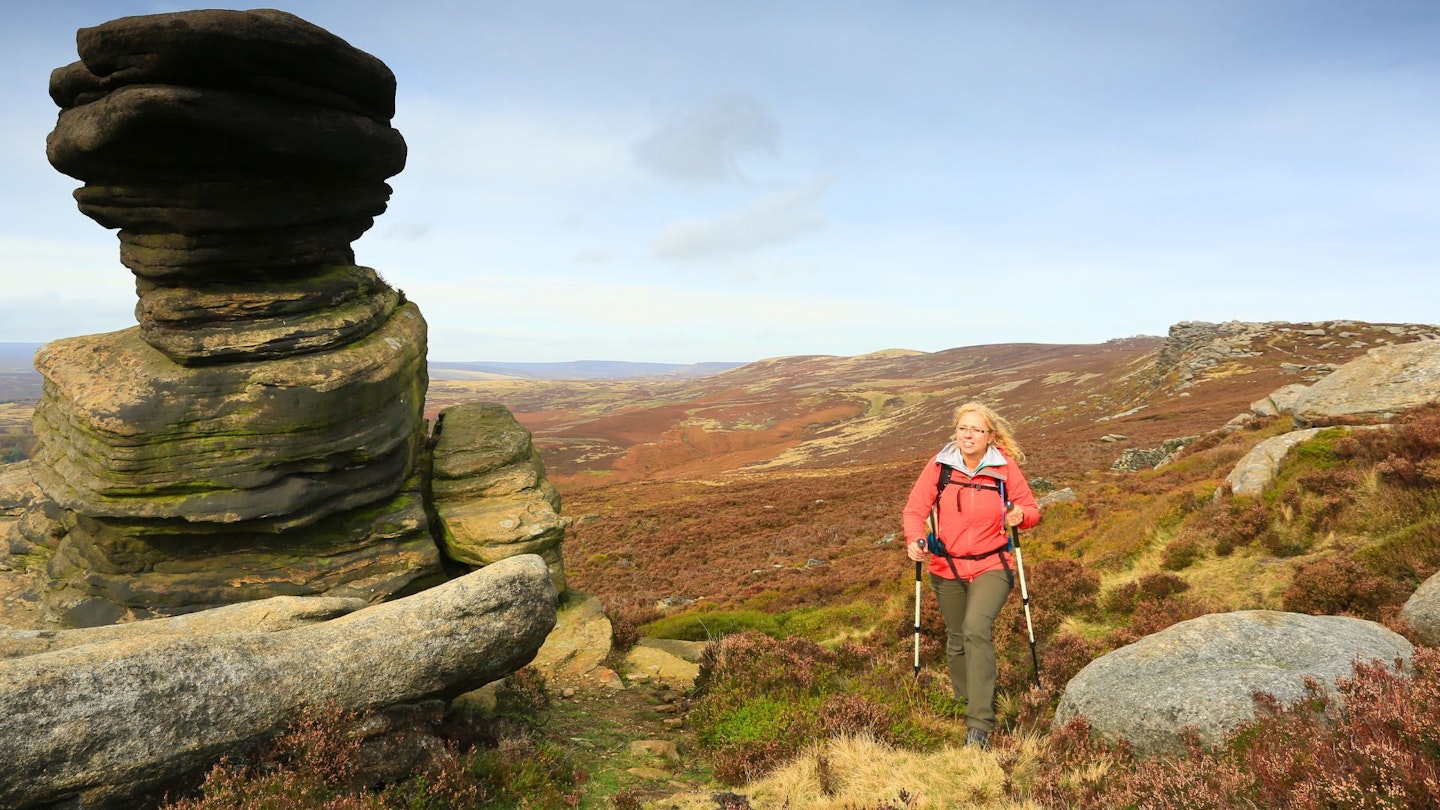
Carbon poles are lighter and stiffer, but more expensive and can be prone to snapping when put under horizontal pressure. Aluminium poles are generally cheaper and more durable, but heavier. Some poles combine both materials.
If you're hiking over rocky mountainous terrain, it's probably best to go for a pole which has more aluminium than carbon – especially if you're carrying a large rucksack and really depend on your poles. But if you're fastpacking on less rugged ground and not carrying so much, then a carbon pole might be more well-suited to your needs.
What’s the best locking mechanism?
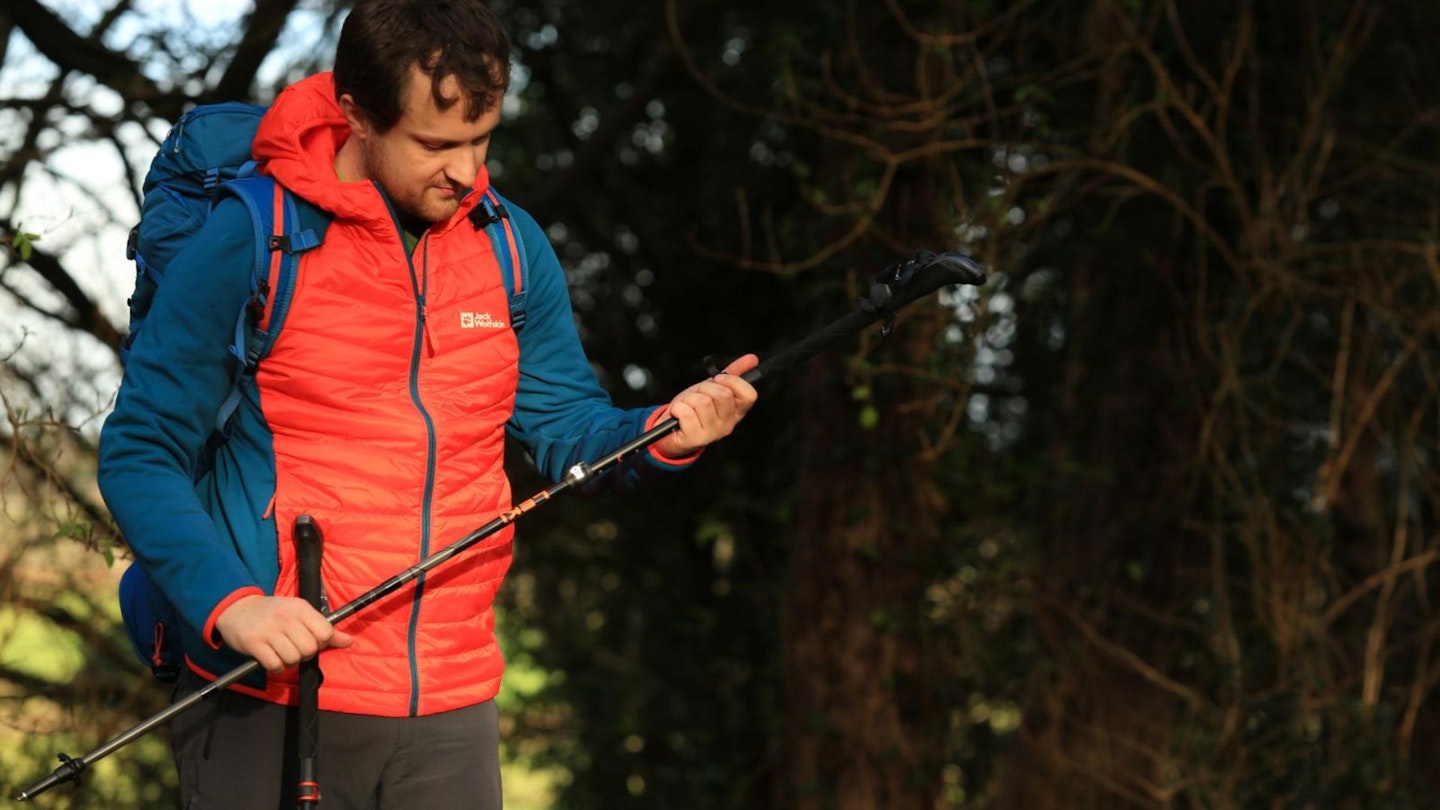
Some walking poles use a twist-lock mechanism, while others have a flip-style lock. A twist-lock normally works by tightening the lower end of the pole. A flip-lock, on the other hand, uses levers to hold the pole in place.
The latter is generally more secure, longer lasting, easier to use and less prone to slippage. They are, on the other hand, slightly heavier. Twist-locks are lighter but more prone to slipping over time, especially in wet weather. They can also be a pain to adjust, needing a lot of tightening to remain in place.
Overall, flip locks are best for heavy use on rugged terrain, whereas twist-locks are suited to lightweight hiking and occasional use.
What’s the best collapsing mechanism?
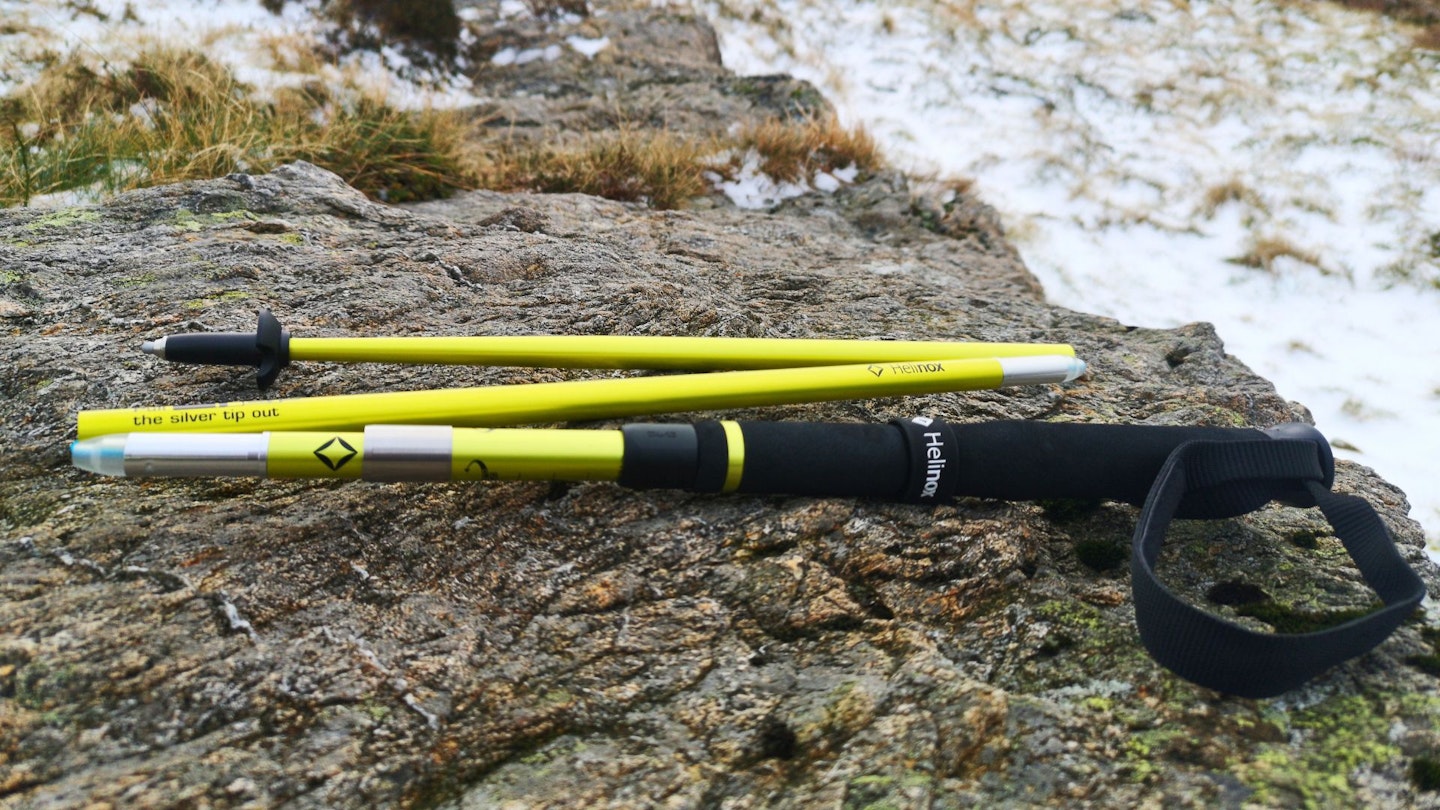
There are two main types of collapsing mechanism: Z-shaped and telescopic. Z-shaped poles fold into thirds (as in the image below), while telescopic poles slide into themselves like a telescope.
A Z-shaped pole is best for compact travel. Rather than poking out of your hiking backpack, it'll use up space inside the pocket or inner compartment. But make sure that the pocket is actually large enough to hold a collapsed pole.
On the other hand, a telescopic pole is potentially harder to transport – but not if you have a pole holder on the outside your rucksack (as many do). Just be aware that if you're flying somewhere, they'll need to fit in your hold luggage.
Overall, a Z-shaped pole works best for rucksacks with large external pockets, as well as for air travel and lightweight, speedy adventures. Opt for a telescopic pole if your rucksack can accommodate it and if you need a more durable option.
How much should a walking pole weigh?
The ideal weight of a walking pole depends on your intended use. An ultralight pole typically weighs between 110-230g (per pole), perfect for trail running or fast hiking.
A standard weight pole weighs around 250g, suiting general use. A heavy duty pole weighs 270g+ and is less likely to let you down on rugged terrain with a heavy load.
What type of handgrip is best?
There's three main options: foam, cork or rubber designs. Foam is the lightest option, but performs badly in wet weather as it absorbs water. It's soft to touch, but will also absorb moisture from sweaty hands.
Cork is heavier but it's excellent for moisture management, as it wicks sweat or rain and won't become slippery. Rubber is the heaviest option and things can get pretty sticky if it's hot, but it's a durable choice.
Overall, cork is probably the most weather-friendly in the UK. For enhanced comfort choose an ergonomic grip with shaping and cushioning. A longer handle allows you to slide your hand up and down, depending on the steepness of terrain, to effectively adjust the pole length on the move.
What other features should I look for?
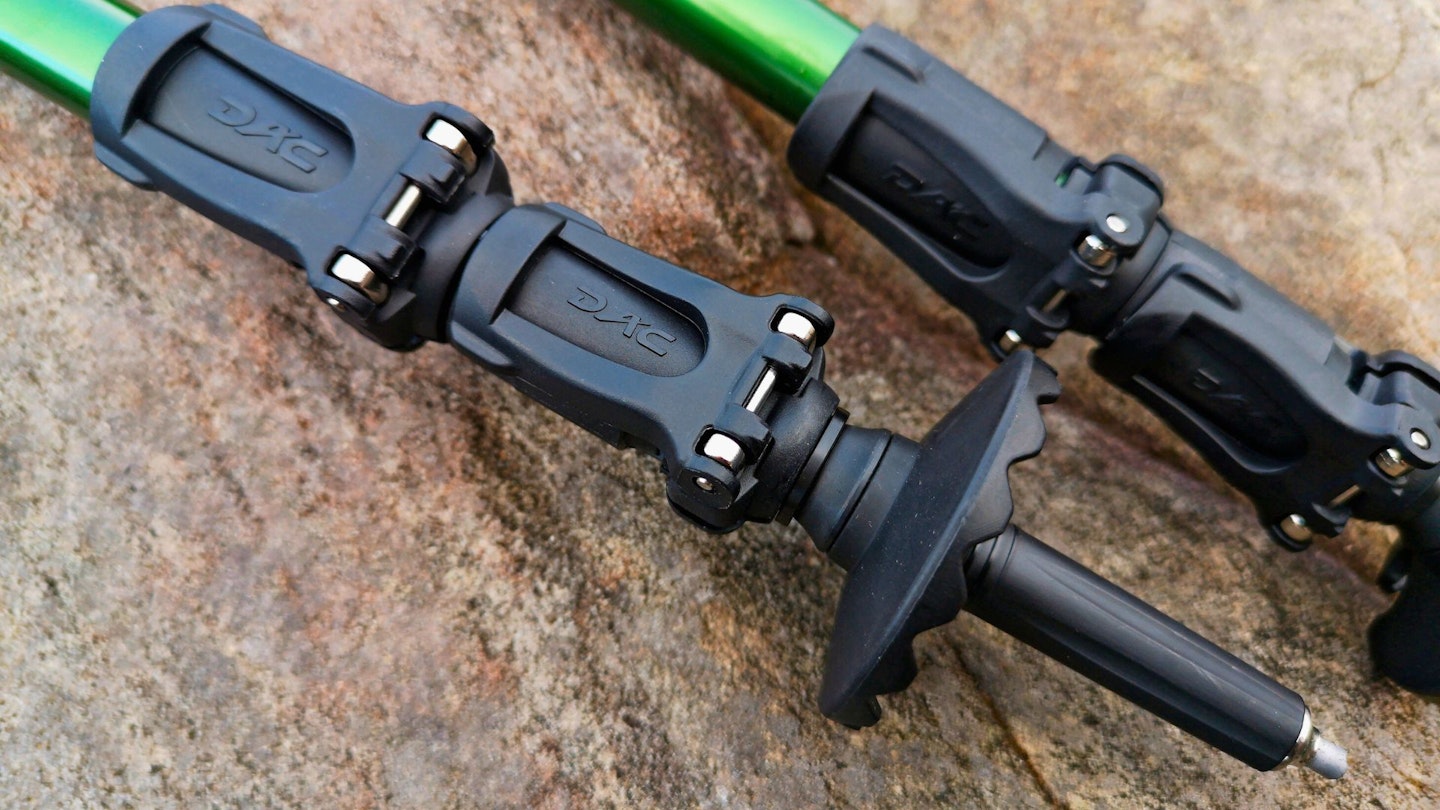
Pole tips are usually made of hardened metal such as tungsten or carbide, housed in a plastic body. You can also get steel tips, which are slightly stronger and more durable.
If you’re walking on roads or very rocky terrain, you can use rubber feet over the tips (these will often come with the poles). Rubber tips also help for avoiding damage to your backpack if you're travelling by plane, but equally you could just tape the tips up for transport.
Wrist straps or slings help prevent poles being dropped. Look out for straps that are padded and adjustable for a boost in comfort.
Baskets are the little round discs near the tip which stop the pole from plunging in the ground. Wider baskets are a good strategy if hiking in snow.
Shock absorption – poles with anti-shock systems use a spring or internal cushioning system to absorb the impact of striking the ground. This is super handy for avoiding overloading your joints, making steep downhills a lot more comfortable.
Make sure there's an on/off switch though, otherwise there'll be less energy transfer when going uphill.
About the author

As the former editor of Walk magazine and Scouting magazine, Matt Jones is one of the most respected names in the UK outdoor industry.
Now a freelance journalist based in the heart of Snowdonia National Park, he’s a vastly experienced gear tester and self-confessed outdoor kit geek. Matt’s been one of our main gear testers for the last couple of years and is the first person we call with any complicated kit queries that need in-depth and forensic analysis.

